Abstract
The Mesolithic burial site Groß Fredenwalde, NE-Germany, discovered in 1962, had remained a poorly understood part of the Mesolithic burial record for decades. Since 2012, the site has been under re-investigation. New discoveries confirm the presence of several single and multiple inhumation graves. Groß Fredenwalde stands out as the largest and one of the oldest Mesolithic cemeteries in North-central Europe. Its use period can be separated into two phases: a main phase in the late seventh millennium cal BC to the early sixth millennium cal BC and a later single burial c. 4900 cal BC. Here the state of research on the site is presented and selected characteristics are discussed in the context of early cemeteries of Northern and North-eastern Europe.
1 Introduction
Human burials from the European Mesolithic display a broad range of different ritual practices. Primary inhumations, secondary interments, partial burials (including skull depositions), and loose human bones as well as ossuaries and cremations are known (Grünberg, 2000; 2016). Remains can be found as single finds, scattered or as interments, in settlements and features without adjacent settlement. With the record of Mesolithic human bone data from all over Europe growing in the second half of the twentieth century (Newell, Constandse-Westermann, & Meiklejohn, 1979), supra-regional comparison was promoted, and subsequently a general development from single to multiple burials was suggested, underlined by then available radiocarbon data (Clark & Neeley, 1987). A more recent analysis of available radiocarbon data questioned the development from single burials to cemetery sites (Meiklejohn, Brinch Petersen, & Babb, 2009), but there is a general agreement that sites with several (often primarily) interred individuals became more numerous in the Late Mesolithic (e.g. Tõrv, 2018, 245f.). Re-examination of existing material from archives and magazines has helped to gain fresh insights into the understanding of Mesolithic burial practices (e.g. Nielsson Stutz, 2003; Tõrv, 2018). New evidence can also be presented from the site of Groß Fredenwalde in North-eastern Germany. Since 2012, new research provided better insight into the structure and dimension of this site (e.g. Jungklaus, Kotula, & Terberger, 2016; Kotula, Piezonka, & Terberger, 2020; Terberger et al., 2015). Re-examination of old materials and new evidence from fieldwork revealed the largest and likewise one of the earliest Mesolithic cemeteries in North-central Europe. Here we present a concise overview on the site including ongoing research and discuss the evidence in the context of early cemeteries of the larger region.
2 Materials and Problems
For the site, general affiliations to more northern and northeastern regions have already been pointed out (Kotula et al., 2020). To investigate on the broader context and connections of Groß Fredenwalde in more detail, selected aspects of the site will be compared with early cemetery sites of Northern and Northeastern Europe. Broadly defined, a cemetery is a place which is recognized by a group to bury all or parts of its community (cp. Gibaja et al., 2015). A minimum number of three individuals (primarily or secondarily interred) and two grave structures are used here to define a cemetery; this represents a common approach, as it more or less excludes a single burial event (cp. e.g. Brinch Petersen, 2015; Larsson, 2004; Meiklejohn & Babb, 2009; Pettitt, 2011). Loose human bones are a problematic category, as they may represent the outcome of different processes (e.g. Brinch Petersen, 2016; Sørensen, 2016) and they are not included in the discussion here. Sites which produced at least one direct or reliable contextual radiocarbon date earlier than 6000 cal BC from Northern Germany, Scandinavia, North-eastern Europe, and western Russia will be primarily focused on in the discussion (15 sites) to provide a more detailed comparison for the time frame in which Groß Fredenwalde emerged. The record of Mesolithic cemetery sites in the Western Baltic area is especially affected by the sea level rise of the Littorina Transgression, as large parts of the Mesolithic landscape including burial sites were submerged (e.g. Amkreutz, 2022; Hartz et al., 2014; Stattegger & Leszczyńska, 2023). Most of the radiocarbon dates from the burials originate from human bones, and considering the expected Mesolithic diet and location of many of the sites close to water bodies (e.g. Sørensen, 2016, 67f.), a reservoir effect can be expected. The problem has been discussed for several sites (e.g. Meadows et al., 2018; Olsen, Heinemeier, Lübke, Lüth, & Terberger, 2010; Schulting et al., 2022; Terberger, Burger, Lüth, Müller, & Piezonka, 2018). Reservoir ages for humans have been calculated e.g. at the Friesack 4 site, NE-Germany, differing widely between 60 and 600 years (Meadows et al., 2018). In some of the discussed cemeteries, bones were in unfavourable preservation condition, and therefore data were obtained from related context, e.g. charcoal from features (e.g. Karsten & Knarrström, 2001; Marciniak, 2001). However, there have been cases where context data contradicted the burial data (e.g. Karsten & Knarrström, 2001; see also Grote & Terberger, 2011), and caution is generally advised.
3 The Site of Groß Fredenwalde
The site of Groß Fredenwalde is located about 80 km NE of Berlin in an upper moraine landscape on top of a prominent hill (111 m a.s.l.) (Figure 1). During construction work for a sign post in 1962, human skeletal remains were detected on top of the hill (Gramsch & Schoknecht, 2003; Schoknecht, 1963) and partly recovered by an amateur (complex I), before two further individuals were excavated by archaeologist Schoknecht on the next day (complex II) (Terberger, Kotula, Jungklaus, & Piezonka, 2021a). The ochre-stained human remains were accompanied by flint blades, animal tooth pendants, and other grave goods. In the 1990s, radiocarbon dating confirmed the Mesolithic age of the assemblage, and in the early 2000s, the then known evidence was presented in a paper, suggesting a multiple burial of 6–8 persons, based on the documentation and a preliminary anthropological analysis (Gramsch & Schoknecht, 2003).
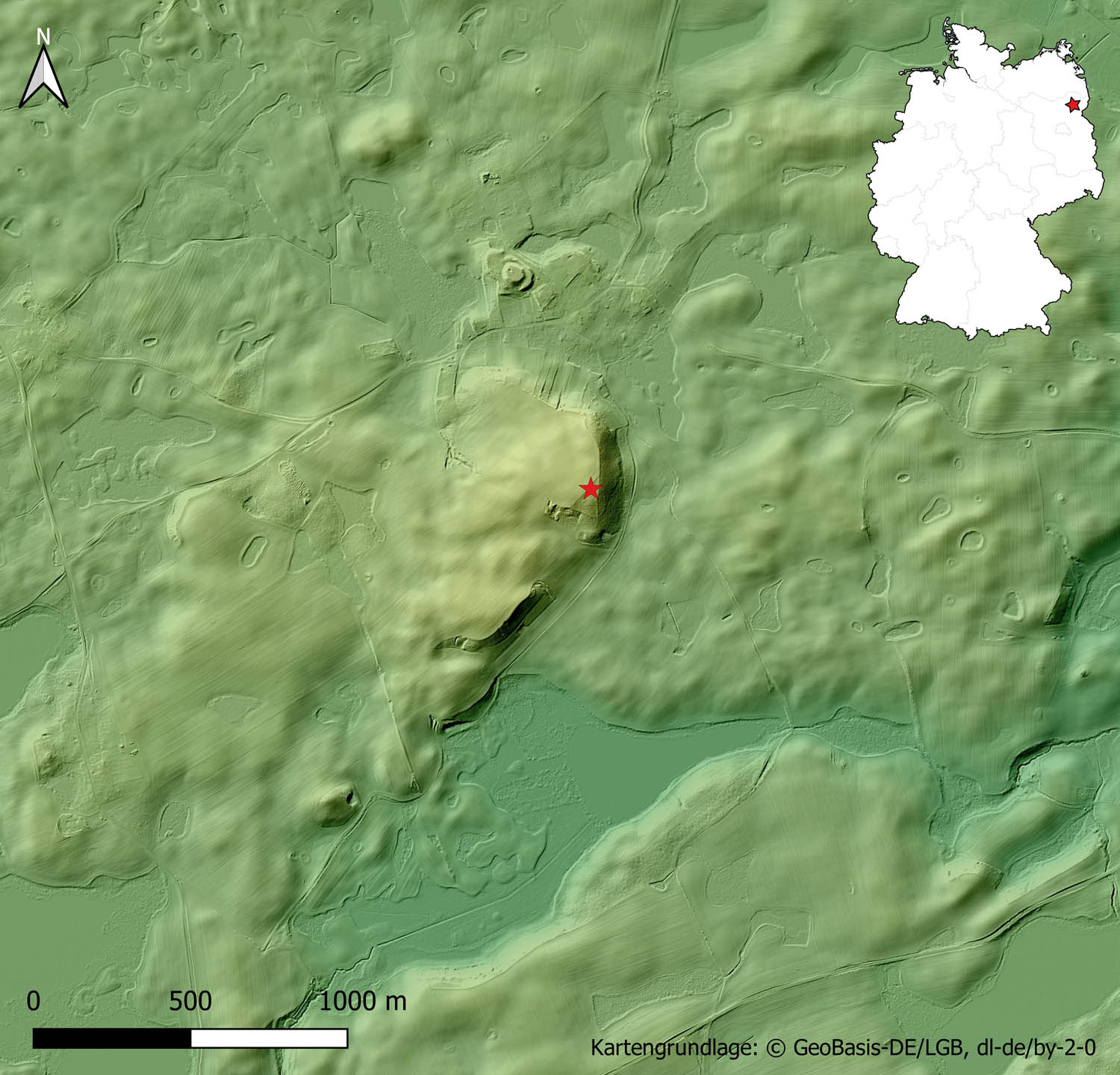
Groß Fredenwalde. Location of the site.
Since 2012, the site has been targeted for new investigation. The human remains of the 1962 findings were thoroughly anthropologically examined for the first time, allowing for the identification of six individuals. In 1962, the findings had been poorly documented with only a sketch drawing of complex II and a few photographs of complex I. Newly discovered archive materials made it possible to reconstruct the position and orientation of the individuals in complex I (Kotula et al., 2020; Terberger et al., 2021a). New fieldwork was carried out at the site to relocate the 1962 construction pit (feature 3) and recover materials overlooked during the rescue excavation. The pit was successfully identified and yielded hundreds of small bone fragments as well as many further grave goods. In the course of these excavations, new burial pits were discovered in close vicinity; they were also targeted for excavation. Interdisciplinary research is ongoing, including palaeogenetics, pollen analysis, and detailed analysis of the grave goods. No Mesolithic settlement traces were uncovered on the hill in the direct vicinity of the burials. The surrounding landscape is characterized by fresh water lakes and provides generally favourable conditions for Mesolithic occupation. Surveys at lake Behrendsee located ca. 500 m south of the site have not provided evidence of Mesolithic settlement activities so far. The closest surface assemblages of Late Mesolithic character are located c. 3–4 km to the southwest. The burial site can therefore be considered a ritual place on a prominent landmark.
3.1 Burials
Until today, 12 individuals in at least 8 graves have been recognized at the site (Table 1), but the area is not fully investigated yet and further graves may be present especially to the southwest of the so far excavated area (Figure 2). The graves are distributed over a small area of c. 5 m × 5 m and do not disturb each other, with the exception of the grave from the more recent phase (feature 1/4, see below), the digging of which destroyed most parts of an older interment (feature 9).
Overview of graves and individuals of Groß Fredenwalde including anthropological information, radiocarbon dates, isotopes, grave goods, and use of ochre (feature 5: preliminary information)
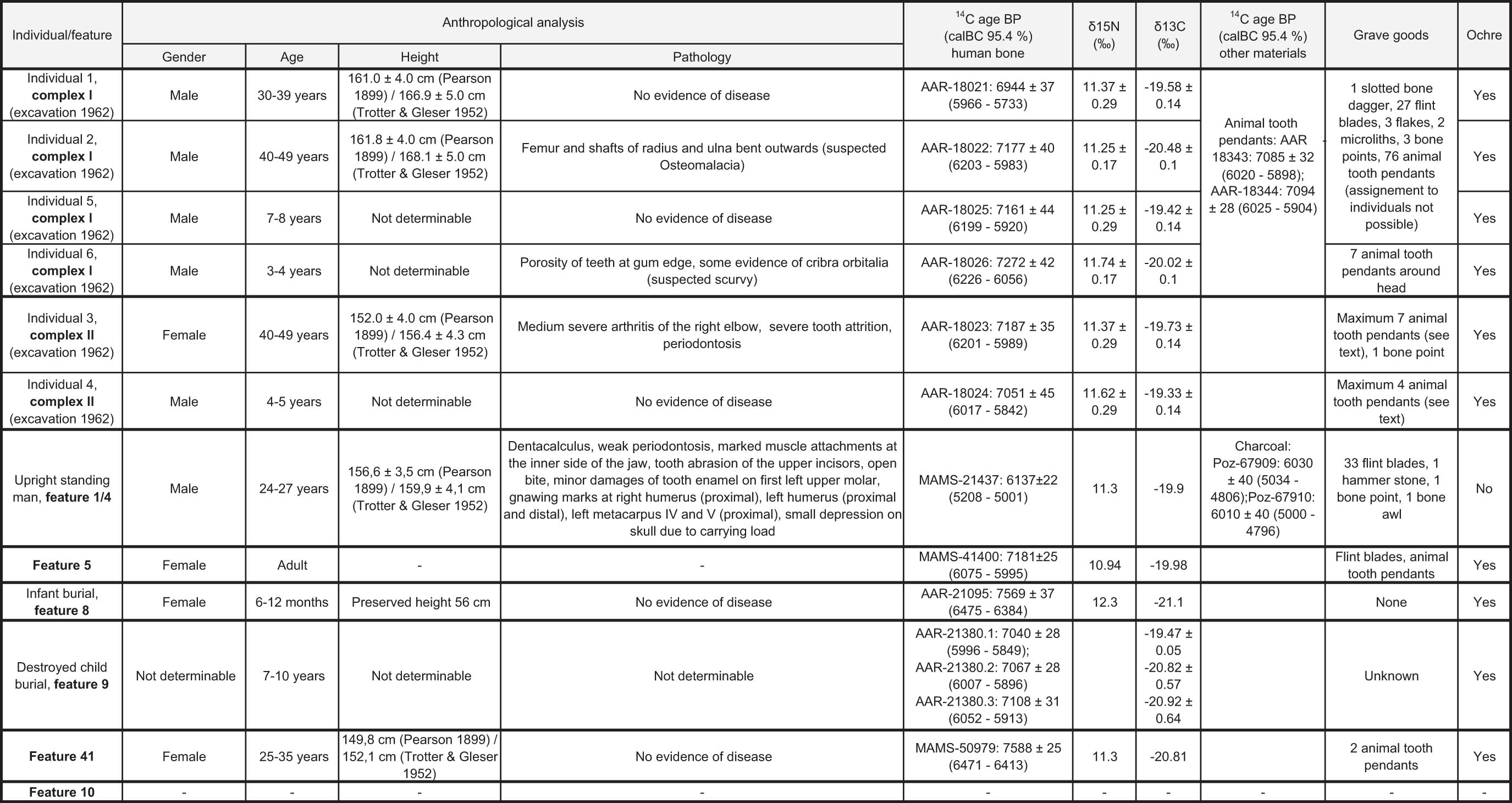 |
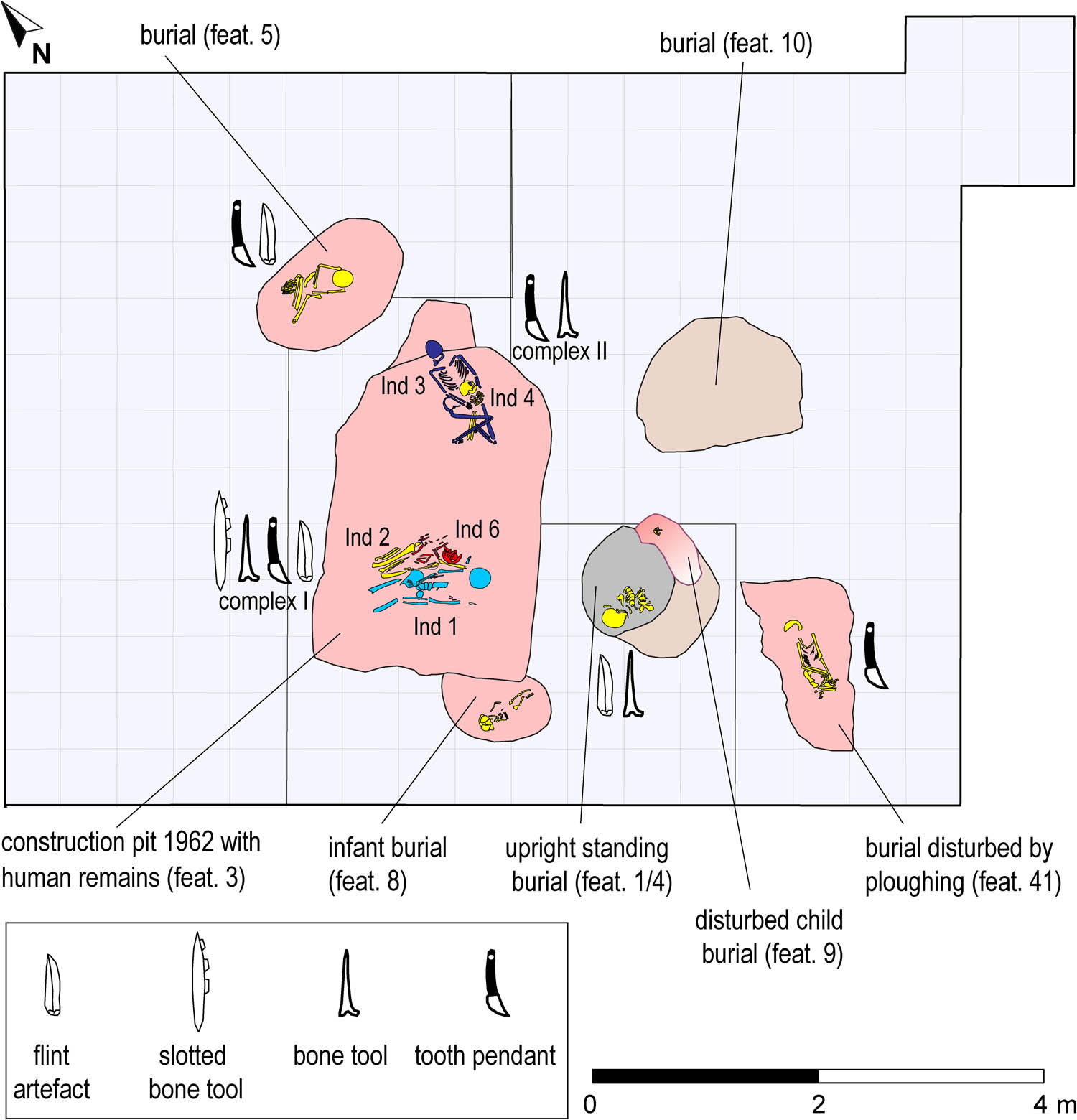
Groß Fredenwalde. Plan of excavated area with different features and positions of skeletons in the features. The location of the burials discovered in 1962 (complex I and II) is reconstructed and the different individuals are emphasized by different colours. Next to the features, the types of grave goods present in each respective grave are symbolized. Burials with confirmed use of ochre coloured red.
The six individuals from 1962 can now be assigned to at least two separate burials (Figure 2; Terberger et al., 2021a): a double burial of a woman (individual 3) and a child (individual 4) (complex II), and a burial of a minimum of two individuals (complex I, a man [individual 2] with a child [individual 6] on his chest) (Figure 3). Another adult male (individual 1) was found by the side of individuals 2 and 6. His orientation would suggest a direct connection to the neighbouring individuals, but the radiocarbon date for this individual indicates a somewhat younger context. If methodological problems are not responsible for the offset, it is possible that the person was interred in the grave on a later occasion (Terberger et al., 2021a). One child that was identified by anthropological analysis (individual 5) could not be detected in the 1962 documentation; these remains may originate from a separate single burial.
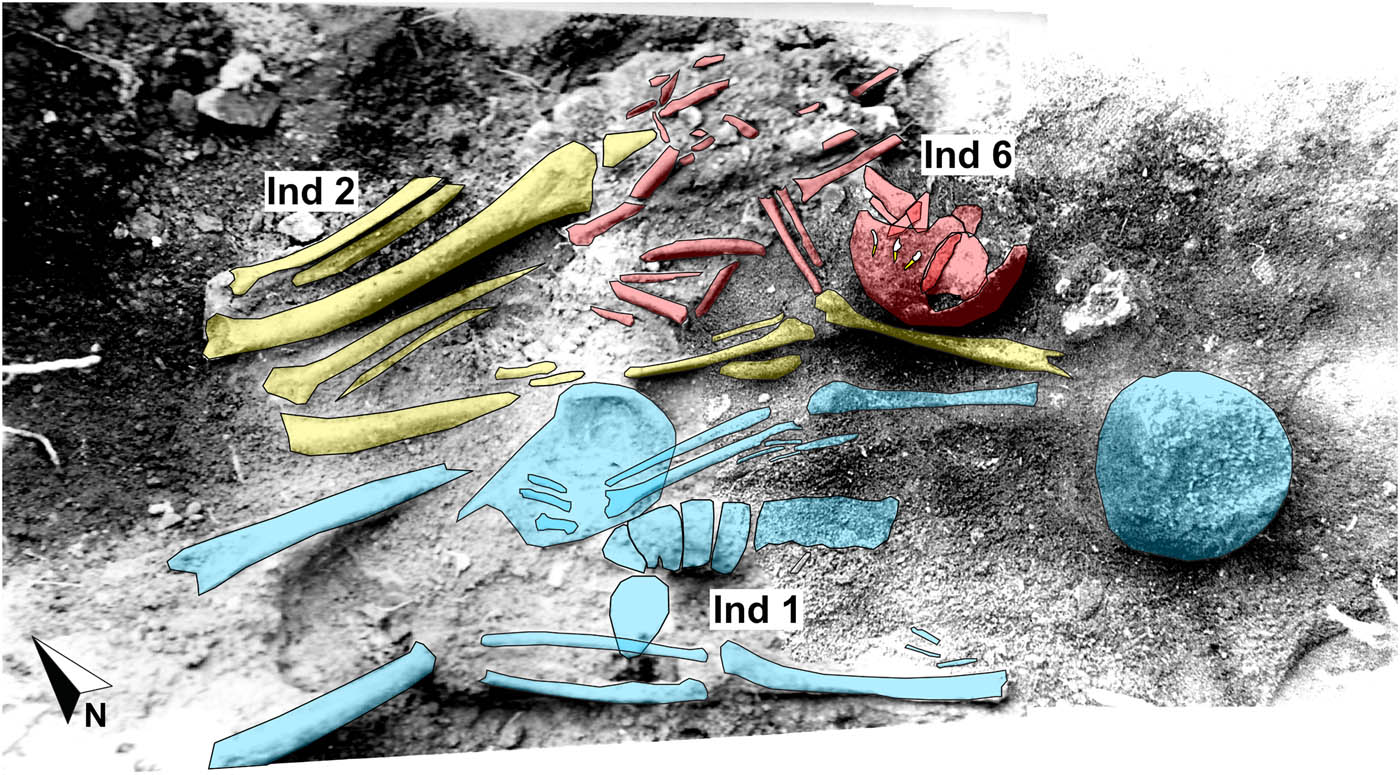
Groß Fredenwalde. Refitted photos of the situation of 1962, excavated on the first day (complex I) with identified individuals no. 1 (blue, male adult), no. 2 (yellow, male adult), and no. 6 (red, 3–4-year-old child) (photo: BLDAM/police Templin).
Next to the re-excavated construction pit, in 2014 an unusual feature could be identified as a single burial of a man interred standing upright (feature 1/4) with an associated fireplace above the interment (Kotula, Jungklaus, Lüdemann, Piezonka, & Terberger, 2022; Terberger et al., 2015). The digging of this burial pit almost completely destroyed an earlier child’s grave (feature 9); only some feet bones of this child covered in ochre were documented in their original position.
To the southwest of feature 3 (construction pit), a small reddish discolouration was discovered in the same year (feature 8). The burial was extracted en-bloc and careful investigation in the laboratory revealed a well preserved infant burial (<1 year) (Figure 4).
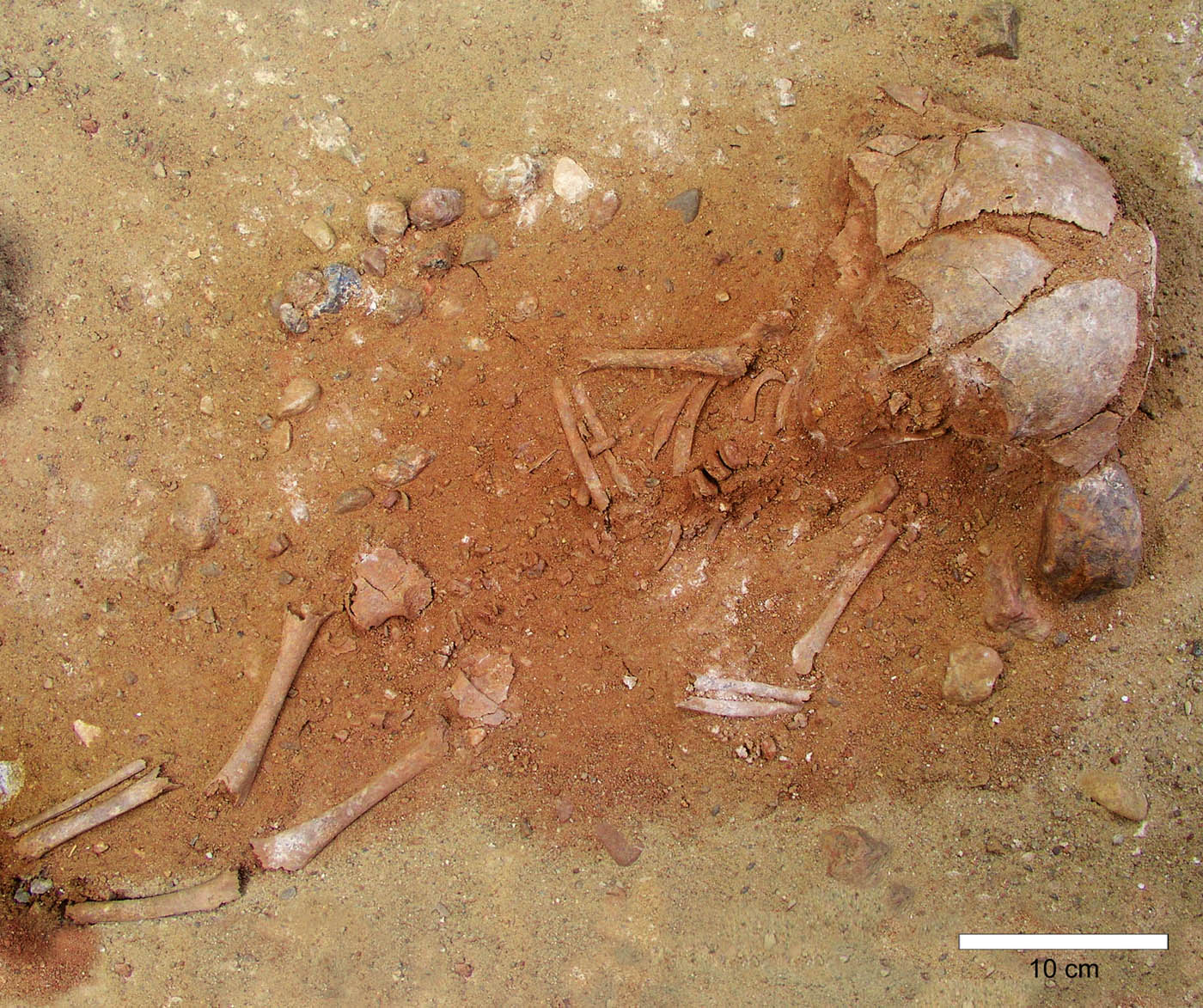
Groß Fredenwalde. Infant burial with ochre (feature 8).
Three more features were explored during recent fieldwork (2019–2020) at the site (features 5, 10, and 41). Feature 5 was an oval pit stained with ochre, located directly north of feature 3. It was recovered as a block and is currently under excavation at Hochschule für Technik und Wirtschaft Berlin. The feature contains a single burial. Another grave (feature 10) was discovered during the excavation in 2019. Below the topsoil, an oval discolouration was documented, with some human bones visible on the surface of the feature directly below the humus layer. The burial remains on site for now. Another burial (feature 41) had been disturbed by ploughing in the twentieth century, and some bones were damaged and relocated in the topsoil. The burial was uncovered as block and excavated under controlled laboratory conditions and accompanying preservation measures. This single inhumation burial was stained with ochre.
Almost all excavated burials were primary inhumations. The complex archaeological situation of feature 1/4 is interpreted as multi-step burial, and 3D modelling is in progress to help to better understand the details of taphonomy. Feature 9 (destroyed child burial) cannot be securely determined, but we suggest a primary inhumation due to the anatomical position of the remaining feet bones. The existing documentation of the material recovered in 1962 also indicates primary inhumation burial of these individuals.
Four adult individuals (individuals 2 and 3 from the 1962 assemblage and individuals from features 5 and 41) were buried lying on their backs or half-sitting (feature 5) with flexed legs. The infant (feature 8) was buried in a supine position with outstretched legs. The position of the child from complex II (individual 4) may also be interpreted as supine or slightly lateral with outstretched legs, but the sketch drawing is somewhat unclear. Individual 1 was buried on his back, but it is unclear, if the legs were stretched or flexed. The young man in feature 1/4 (later burial phase) was put into his grave pit standing upright. The position of the other individuals from the 1962 assemblage and the child from feature 9 remains unclear, while for feature 10, information is not available.
Isotope values of all individuals indicate an aquatic component in the nutrition, matching a hunter-gatherer-fisher lifestyle (Table 1). The lack of evidence for dental caries indicates a low proportion of carbohydrates in the diet. Anthropological analysis shows few signs of diseases and no traces of violence. The right arm of individual 3 shows signs of arthritis. The bent upper legs of individual 2 indicate osteomalacia (weak bones), likely caused by vitamin D deficiency. The infant (feature 8) shows low C13 values compared to the other individuals, hinting (too) early weaning. Another child (individual 6) displays cribra orbitalia (porous bone in the eye socket), possibly caused by scurvy (Jungklaus et al., 2016). Most of the individuals from the 1962 recovery (individual 2 was excluded due to bad preservation) as well as the individuals from feature 1/4 and 8 were targeted for palaeogenetic analysis. All individuals belong to the so-called Oberkassel ancestry cluster with U5 mtDNA haplogroup (Posth et al., 2023). Groß Fredenwalde is the earliest central European site known so far to display influence/admixture from eastern hunter-gatherers (Sidelkino ancestry). The more recent individual from feature 1/4, who was a contemporary neighbour of early farming groups in the Uckermark region (see below), does not show any signs of admixture with the immigrant farmers.
3.2 Chronology
According to the present radiocarbon data (11 individuals), the burials can be divided into two phases: phase 1 c. 6450/6400 (6300/6200)–5800 cal BC (10 individuals) and phase 2 c. 4900 cal BC (1 individual) (Figure 5).
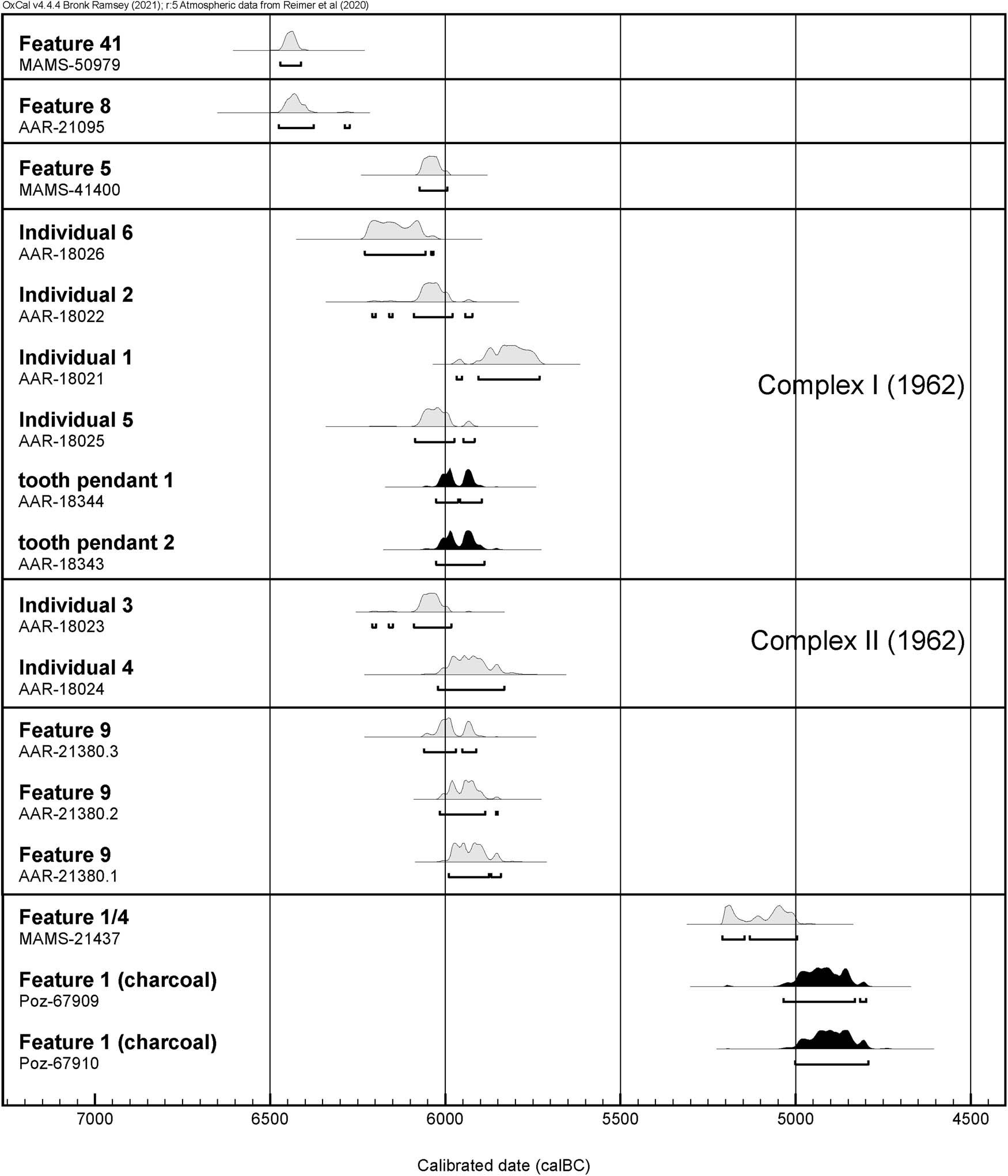
Groß Fredenwalde. Calibrated radiocarbon dates. Black: terrestrial data.
The single burials of an infant (feature 8) and an adult (feature 41) are the earliest interments and date to c. 6450–6400 cal BC, but a reservoir effect has to be taken into consideration. The feature 5 single burial dates into the latest centuries of the seventh millennium cal BC. The double interment of the adult individual with flexed legs (individual 2) and a child (individual 6) on his chest from complex I provides data c. 6150–6050 cal BC. The adult individual positioned directly next to it in supine position (individual 1) dates somewhat later, at c. 5950–5750 cal BC (see above). The other child from complex I (individual 5) is dated to c. 6000 cal BC. Two animal tooth pendants from the re-excavated construction pit are certainly grave goods from complex I and date to 6000–5900 cal BC. If we consider the dated pendants to provide the most reliable dates, we can place complex I into the very early sixth millennium cal BC. In this case, the AMS-dates of the human individuals from the same context (complex I) show a reservoir effect of up to 200 years. The double burial of complex II (individuals 3 and 4) similarly dates to c. 6000 cal BC, as well as the disturbed child burial (feature 9, c. 6000–5900 cal BC). These burials are also likely to be affected by a reservoir effect. In conclusion, the period from c. 6300/6200–5800 cal BC probably marks the first phase of use of the cemetery according to the present data.
After a gap of c. 900 years, the place was used again as a cemetery (feature 1/4). Here the human bone data suggest an age of c. 5200–5000 cal BC, while charcoal from the fireplace on top of the burial pit provides a date c. 4900 cal BC; the latter is considered to be directly connected to the burial rite and as more reliable for dating the event. A reservoir effect of up to 300 years can therefore be expected for the human bone data. At that time, Neolithic Linearband pottery culture farmers had already established in the Uckermark region only a few kilometres away (Terberger, Kabaciński, & Kotula, 2021b).
3.3 Grave Goods
From the 1962 recovery, 17 flint artefacts are known, all of them connected with complex I. The new excavations yielded more flint artefacts in the construction pit, of which 15 can probably be connected to complex I (individuals 1, 2, 5, and 6). The materials connected to this grave(s) therefore consist of 27 blades, including two truncated blades, one of them very large (length: 111 mm) (Figure 6), and two trapeze microliths as well as some flakes. Two fragments of a slotted bone dagger with decoration were also found in 1962 (complex I) and they can be supplemented with another, newly discovered fragment (Figure 7).
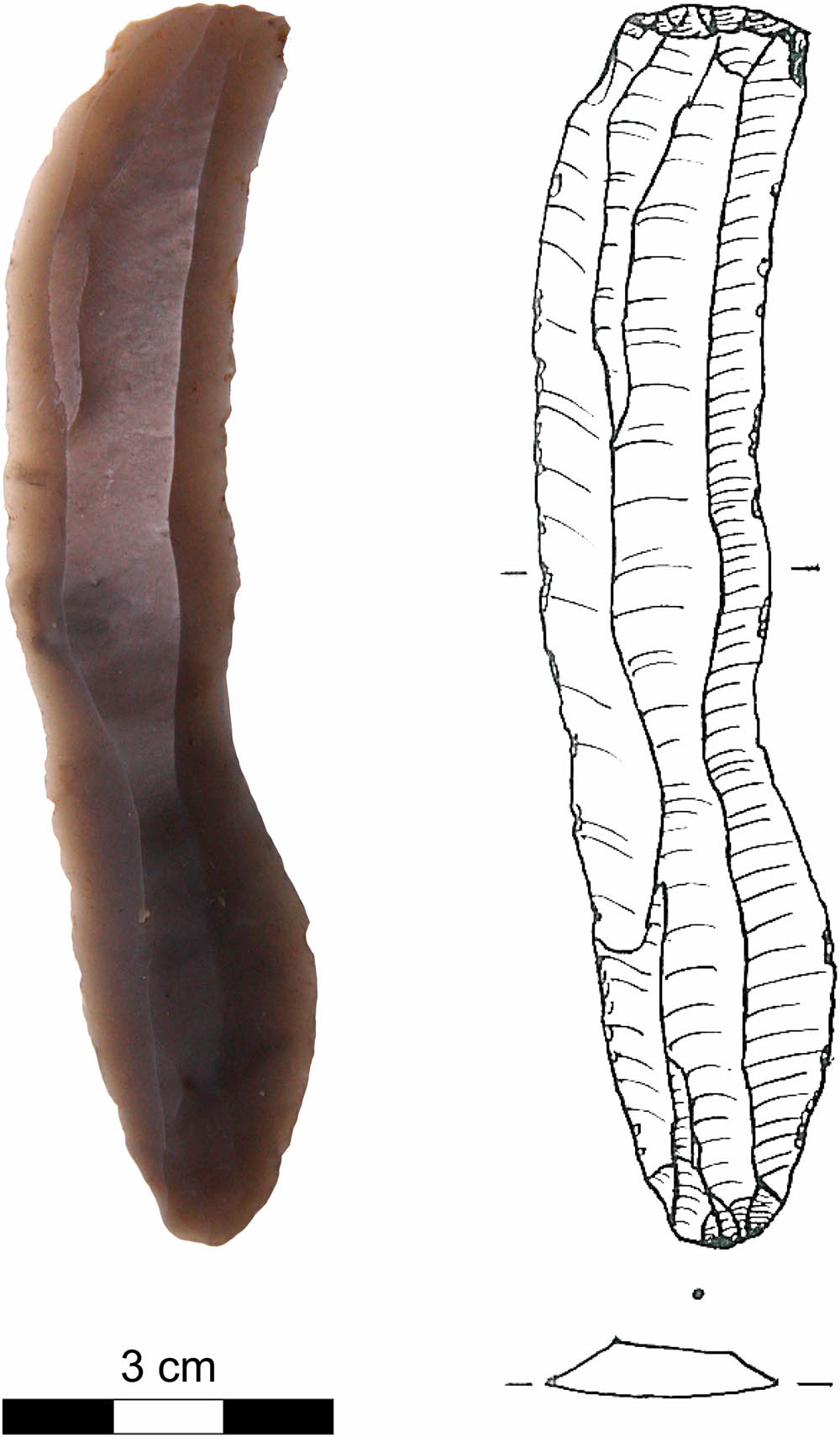
Groß Fredenwalde. Large truncated blade from complex I (drawing after Gramsch & Schoknecht, 2003).

Groß Fredenwalde. Slotted bone dagger with decoration (photo: BLDAM/Brather; drawing after Gramsch & Schoknecht, 2003).
Overall, 90 tooth pendants can be assigned to complexes I and II, but for only a few of them detailed information is available. Almost all tooth pendants were made of red deer teeth. Seven specimens can be connected with the double burial of individuals 3 and 4 (complex II). Three of them were found close to the skull of individual 3; four more were located near the leg bones and (some) may be connected to the child (individual 4) (Schoknecht, 1963). This leaves 83 pendants for complex I, indicating c. 20 pendants on average per individual, thus signalling richly equipped burials. Seven pendants are considered to belong to the headgear of a child (individual 6; five of them visible in Figure 8; cp. Gramsch & Schoknecht, 2003, p. 17). It is well possible that one of the individuals of complex I was more richly equipped than the others. One richly furnished male individual (no. 1 or 2) might well be suggested by the large truncated blade (knife) and the slotted bone dagger. Other artefacts include a bone point that was found at the side of individual 3 (complex II); three more bone points are connected with complex I. Some loam pieces found in 1962 and during recent field work (feature 3) remain enigmatic (Gramsch & Schoknecht, 2003). The newly discovered feature 41 contained two tooth pendants next to the individual. Preliminary information is available for feature 5, where tooth pendants in the skull area and few flint blades were recorded.
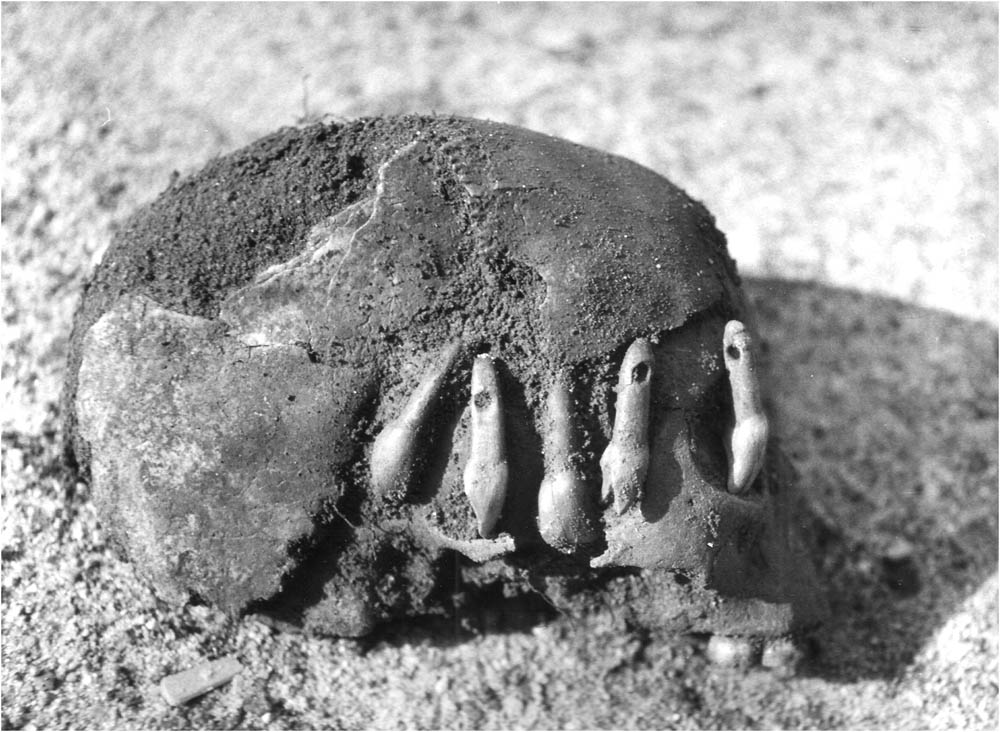
Groß Fredenwalde. Skull of child (individual 6) recovered in 1962 with animal tooth pendants (BLDAM/police Templin).
The grave goods of the later grave (feature 1/4) include 33 flint blades, a small flint core later re-used as a hammerstone, a bone awl, and a bone point (Kotula et al., 2022). The flint material includes two large blades with truncation (Figure 9). For feature 10, no information on grave goods is available. All burials at Groß Fredenwalde, except the more recent grave (feature 1/4), contained ochre (feature 10: no information).
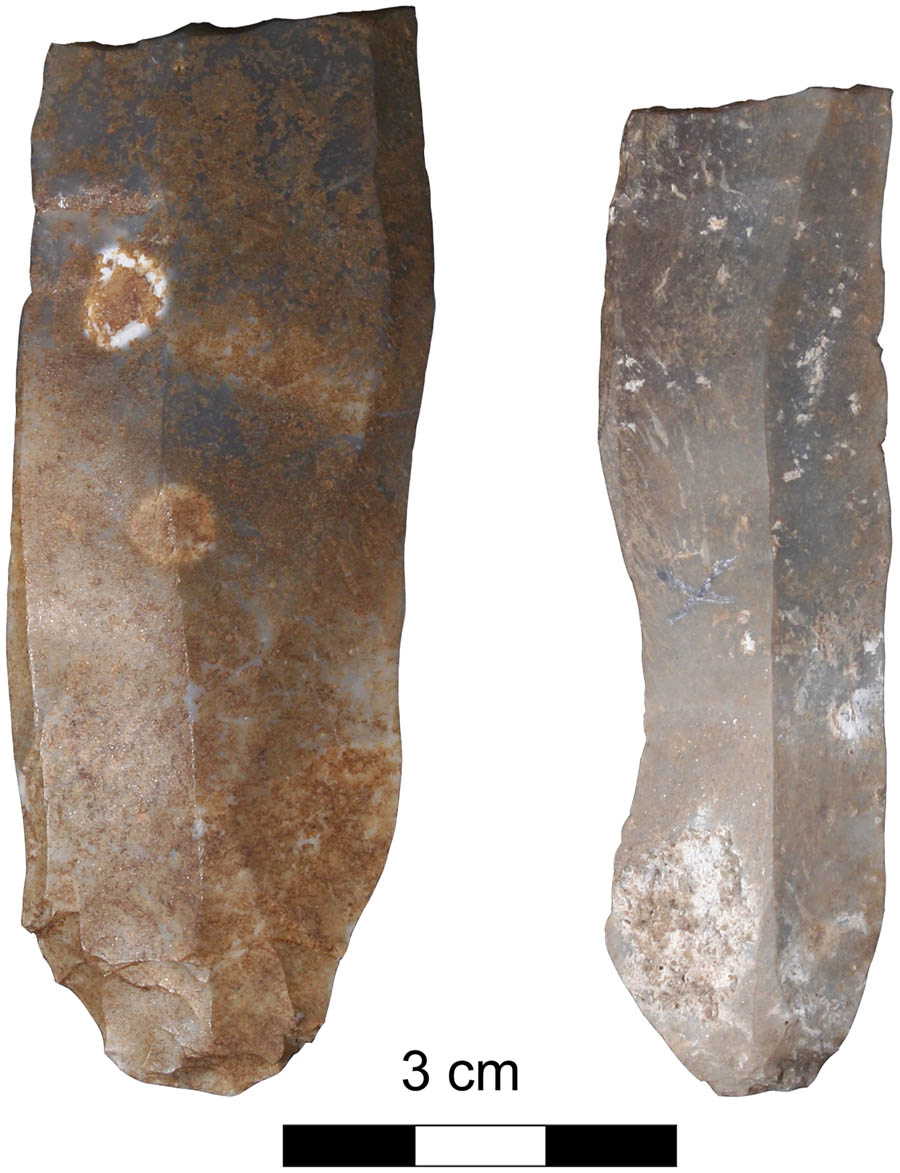
Groß Fredenwalde. Large truncated blades from feature 1/4.
4 Groß Fredenwalde in the Context of Early Cemeteries of Northern Europe
4.1 Chronology
Groß Fredenwalde is one of the earliest cemeteries in North-central Europe. Older Mesolithic human remains in NE-Germany are only represented by loose human bones discovered at Friesack (Terberger et al., 2018). A very early cemetery with primary inhumations is present at the Popovo site in Russia in North-eastern Europe (Figure 10), besides other cemetery sites with secondary interments of human remains in the Northeast of Europe (Peschanitsa and Minino I) (Oshibkina, 2008, 2016). During the Boreal, the possible primary inhumation cemetery Hummervikholmen, Norway, with remains of three to five individuals in secondary sediments (Skar, Lidén, Eriksson, & Sellevold, 2016) and the site Mszano in eastern Poland with burnt primary inhumations (Marciniak, 2001) testify to the presence of (primary) inhumation burial grounds in different regions of North-central and Northern Europe far-away from each other. In the more numerous evidence of cemeteries in the early Atlantic, primary inhumations are by far the dominant burial type (Figure 11). Cremations are rarely present at the early cemeteries in Northern and North-eastern Europe, but they are known from large areas of Europe since the early Mesolithic before becoming rather marginal from the Late Mesolithic onwards (Bugajska, 2020). Recently, a possible early Mesolithic cremation was reported from Duvensee, Schleswig-Holstein, representing the first discovery of a Mesolithic grave in North-western Germany, if the burial character of the assemblage can be verified (https://www.uni-kiel.de/de/detailansicht/news/20221310-grabfund-duvensee). However, sites like the unique cemetery at Dudka, Poland, testify to highly variable burial rituals (including cremation) in the Late Mesolithic and para-Neolithic (Bugajska, 2020; Bugajska & Gumiński, 2016; Gumiński & Bugajska, 2016). The emergence of more cemetery sites with primary inhumation burials in the course of the early Atlantic hints at an increasing unification of burial customs on a more general scale at this time, and the radiocarbon data place Groß Fredenwalde into this context.
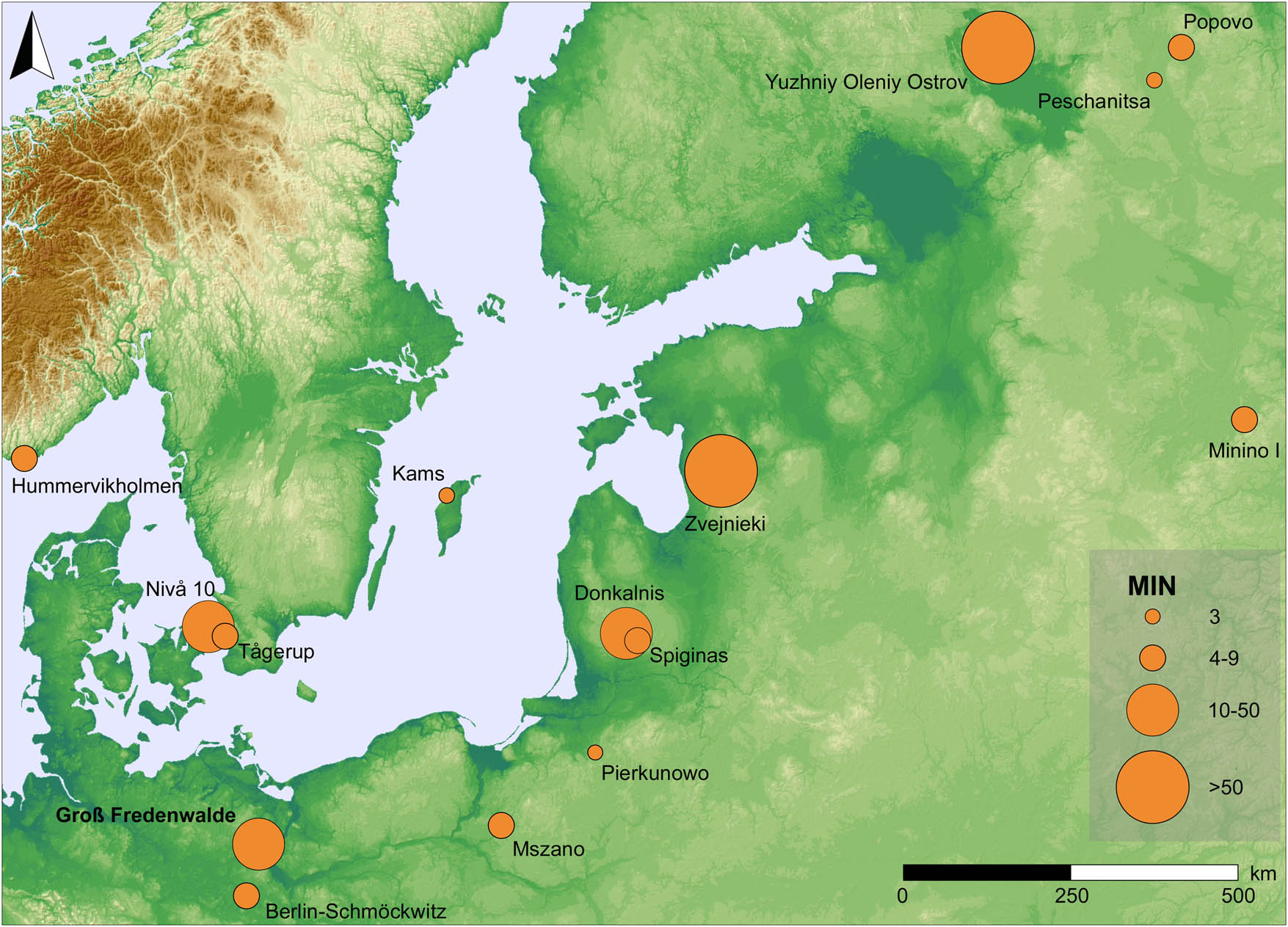
Mesolithic cemetery sites (MIN > 2) in Northern and North-eastern Europe with radiocarbon evidence older than 6000 cal BC (data after Butrimas, 2016; Grünberg, 2000; Jensen, 2016; Karsten & Knarrström, 2001; Larsson & Zagorska, 2006; Marciniak, 2001; Oshibkina, 2016; Piotrowska et al., 2019; Schulting et al., 2022; Skar et al., 2016; Wood et al., 2013).
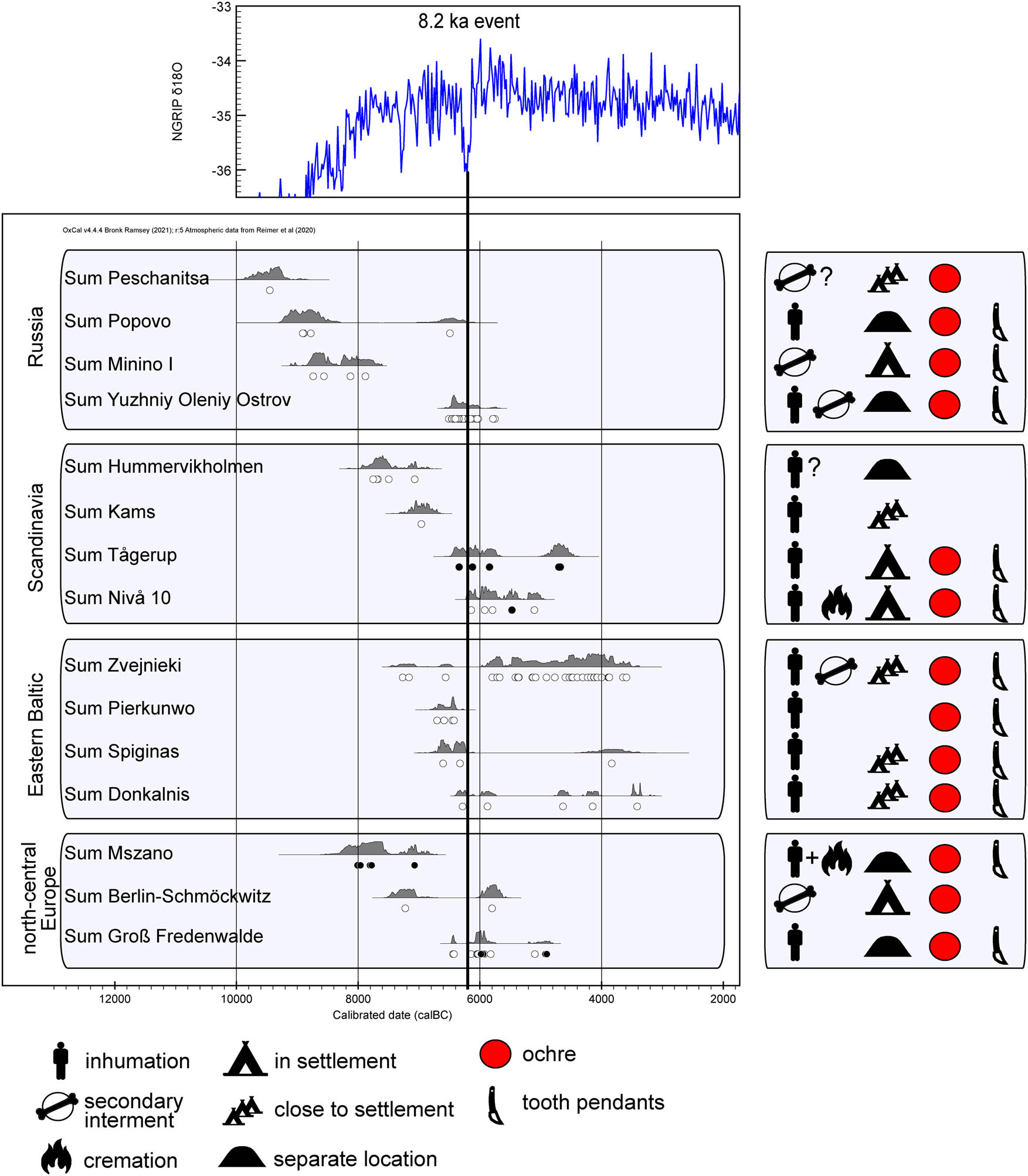
Radiocarbon data of Mesolithic cemetery sites in Northern and North-eastern Europe with radiocarbon evidence older than 6000 cal BC with information on selected ritual aspects. White dot: human bone data, black dot: other contextual data. For Peschanitsa and Hummervikholmen, the type of interment is not entirely clear. The large cemetery sites Zvejnieki and Yuzhniy Oleniy Ostrov represent mostly primary inhumations and very few secondary interments. At Mszano, primary inhumation burials were burned (data after Butrimas, 2016; Grünberg, 2000; Jensen, 2016; Karsten & Knarrström, 2001; Larsson & Zagorska, 2006; Marciniak, 2001; Oshibkina, 2016; Piotrowska et al., 2019; Schulting et al., 2022; Skar et al., 2016; Wood et al., 2013).
The number of individuals interred and the period of use of the cemeteries vary widely (Figures 10 and 11). The duration or time of use of the discussed sites with more than one radiocarbon date displays a considerable chronological variation, ranging from c. 280 years (Pierkunowo, Poland) to c. 3700 years (Zvejnieki, Latvia) with a mean of c. 1600 years (oldest and youngest date mean cal BC considered) (Larsson & Zagorska, 2006; Piotrowska, Tomczyk, Pawełczyk, & Stanaczek, 2019). The largest time span of use is present in the eastern Baltic, where the sites Spiginas and Donkalnis span almost three millennia (Butrimas, 2016), and Zvejnieki even more. Groß Fredenwalde covers very much the middle ground with a duration of c. 1400 years, but the main phase was considerably shorter (c. 400/500 years). At Yuzhniy Oleniy Ostrov, recent modelling of the data indicates a time span of 300 years or less for the interments (Schulting et al., 2022). From this site, 177 graves are known, but it is suspected that originally c. 400 graves were present (Schulting et al., 2022). This would hint at an extraordinary number of 59 (n = 177 graves) or even 133 (n = 400 graves) burials per century for this site. The Popovo site, too, shows high activity within a very restricted time frame, if one outlier grave date is excluded. It is calculated that four individuals per century were interred at the large Zvejnieki cemetery over a long period of time. Contrarily, at the site Spiginas, only four individuals were uncovered, buried over a time of c. 2800 years but with a long hiatus in between. In the main burial phase of Groß Fredenwalde c. 6300/6200–5800 cal BC, c. two to three individuals per century were buried there. Estimations may considerably change with a re-assessment of site chronology. However, sites not fully investigated may not generally contradict robust chronology (Schulting et al., 2022 suppl.).
One characteristic of the Groß Fredenwalde burial site is a hiatus. The “standing man burial” is c. 900 years younger than the latest graves from the earlier phase of the cemetery, and it is also the only grave disturbing an earlier interment, indicating that the group performing this burial ritual was not aware of and/or did not care about the earlier grave(s). Similarly, a significant share of the sites under consideration here is characterized by younger outlier data, hinting at a main phase of use and a later resumption, if it is not data contamination or incomplete site information that is responsible for the hiatus. A hiatus may also reflect changing environmental conditions at a site, e.g. displayed at Nivå 10 (Jensen, 2016). There seems to have been a regular resumption of burial(s) on sites after long gaps. At Mszano, the unique type of bi-ritual burial only known from this site was again carried out after a break of c. 700 years without disturbing the older graves (Marciniak, 2001), indicating knowledge handed down and a vitality of this tradition, in contrast to the more recent Groß Fredenwalde grave. This may also be true for Tågerup, where grave 4 was located amidst other graves respecting their borders, despite being c. 1,000 years younger (Karsten & Knarrström, 2001). Another grave from the site is typologically also dated to around the same young age, but is located c. 100 m to the east, clearly separated from the other graves. In Lithuania, Spiginas grave 1 is dated more than 2,000 years later than the other two Mesolithic graves, but located c. 1 m away from an older grave without disturbing it (Butrimas, 2016); the same accounts for Popovo grave VI (Oshibkina, 2016). In a few cases, graves were disturbed by later interments at the large cemeteries Zvejnieki and Yuzhniy Oleniy Ostrov (Gurina, 1956; Zagorskis, 2004). For the extensively studied Vedbaek and Skateholm cemeteries, most graves appear to have been remembered and respected (Nielsson Stutz, 2003). Being aware of existing graves is also reported from other regions (Tõrv, 2018, 249f.). The Groß Fredenwalde case is especially interesting, as it is contemporaneous with the presence of early Neolithic settlers in the region and may therefore represent a specific local response/reaction.
The data indicate that the early burial phase at Groß Fredenwalde took place in the late seventh and earliest sixth millennium cal BC, placing this phase chronologically close to/soon after the 8.2 ka cooling event. Some indications in the archaeological record of Europe and other areas hint at societal and technological changes connected with this event (e.g. Clare, Rohling, Weninger, & Hilpert, 2008; Gehlen & Schön, 2005; Schulting et al., 2022). The re-assessment of the Yuzhniy Oleniy Ostrov cemetery confirms a narrow time frame of use of the site around the mentioned cold phase, probably connected with the competition for resources (Schulting et al., 2022). At Groß Fredenwalde, the isotope values of the infant burial indicate early weaning or breastfeeding disorders. For two other individuals of the main burial phase, anthropological analysis indicates scurvy and vitamin D deficiency. Five of the nine individuals dated to that phase are children, which can indicate unfavourable conditions for more vulnerable individuals. The proportion of children in Groß Fredenwalde is significantly higher than the average from Mesolithic burial grounds in Europe (Grünberg, 2000). However, the age distribution at the cemetery may generally reflect a rather realistic hunter-gatherer mortality pattern without age-related selection (Volk & Atkinson, 2013; cf. Schulting, 1996). The anthropological evidence does not provide strong support for unfavourable living conditions. A possible causal relation of the 8.2 ka event and the Groß Fredenwalde cemetery needs to be investigated in more detail.
4.2 Location and Ritual
One outstanding characteristic of the Groß Fredenwalde site is the location on top of a prominent hill without adjacent settlement known so far. The occurrence of cemeteries has been interpreted as a sign of symbolic territorial claims in a competition about resources and underlying sedentism (e.g. Saxe, 1970; cf. Conneller, 2013). A connection of socio-ecological stress during the 8.2 ka cooling event with burial activity at Yuzhniy Oleniy Ostrov has already been mentioned (Schulting et al., 2022). In Scandinavia, a connection of burial sites to water has been suggested, and is interpreted as part of the cosmology (Sørensen, 2016). Some of the large Mesolithic burial sites in Scandinavia are situated inside settlement areas (e.g. Brinch Petersen, 2015), and two of the early cemeteries show burials in settlements, too (Figure 11). However, some burial grounds form separated localities like Groß Fredenwalde. The Yuzhniy Oleniy Ostrov burial site is situated on an island, and no settlement traces could be found closely related to the site (Jacobs, 1995); a comparable local situation has been suggested for Popovo (Oshibkina, 2016). The Hummervikholmen burials were located at a sheltered beach in a lagoon environment without adjacent settlement traces (Skar et al., 2016). In the Mszano burial area, some Mesolithic settlement finds are present, but the location is thought to be of exclusively ritual character during its use as cemetery site (Marciniak, 2001). A rather typical location can be stated for the Spiginas and Donkalnis cemeteries, which were located on islands, thus separated but not far from settlement areas (Butrimas, 2016). Zvejnieki, too, was located on an island, with the burial areas at the highest point and adjacent settlement areas at the slopes (Zagorska, 2016). Kams was located close to Stone Age settlement remains, but their relation to the graves remains somewhat unclear (Arwidsson, 1949; Grünberg, 2000). The lack of settlement traces probably indicates that the Groß Fredenwalde location was chosen as a specific landmark to communicate identity/territory by a certain group.
Identity and group tradition can also be expressed in the treatment of the dead. A typical burial treatment connected with the Mesolithic is the use of ochre, which is more common in Northern and North-eastern Europe (Grünberg, 2013a) and is also present in Groß Fredenwalde. It is often connected with the primary inhumation burial practice, but one cremation from Nivå (grave A124) was also covered with ochre (Jensen, 2016). Among the discussed sites, only the Kams’ individuals and the re-located underwater finds from Hummervikholmen did not show any ochre at all (Figure 11). At Zvejnieki, ochre is abundantly used in the Mesolithic period; its use decreases in the later graves (Zagorska, 2008). It was also present in all graves at other eastern European burial sites like Spiginas and Donkalnis, Pierkunowo, and Mszano, while only some of the graves at the Scandinavian sites Tågerup and Nivå were covered with the red dye. Similar to Groß Fredenwalde, many eastern German burial sites display the use of ochre, like Bad Dürrenberg, Schöpsdorf, Criewen, and Rathsdorf (Geisler & Wetzel, 1999; Grünberg, 2016; Ismail-Weber, 2017; Wechler, 1989). The last interment in Groß Fredenwalde was not equipped with the red dye, underlining a hiatus of tradition.
In this later grave also no tooth pendants were found, but they are present in some of the older burials at the site. With more than 90 tooth pendants, Groß Fredenwalde is rich in these ornaments of animal origin. They were almost exclusively made of red deer teeth. Remains of this species were widely distributed in Mesolithic burials and prevail in western Europe, while grave furnishings in Northern and North-eastern Europe display more diverse choices (Grünberg, 2013b). The species of tooth pendants is determined by the regional environment. Among the investigated sites, animal tooth pendants are present in most cases, except the secondary burial sites of Peschanitsa and Berlin-Schmöckwitz as well as the re-located bones from Hummervikholmen, and the Kams interments (Figure 11). They are especially abundant at the northeastern and eastern sites. At Groß Fredenwalde, most of the tooth pendants cannot be connected with specific individuals (see above). However, one child (complex I, individual 6) was adorned with a row of tooth pendants around the head. Equally some pendants were recorded in the head area of the woman from complex II (individual 3) and feature 5. This indicates decorated headgear, and parallels can be found e.g. further east at Mszano, Donkalnis, Zvejnieki, and Yuzhniy Oleniy Ostrov as well as at later cemeteries in southern Scandinavia like Skateholm (Butrimas, 2016; Gurina, 1956; Larsson, 2006; Marciniak, 2001; cp. Grünberg, 2013b).
The slotted dagger finds parallels especially in Denmark (Voss, 1960). The type is rare in Mesolithic graves (Kotula et al., 2020). A close connection between the Danish and the Northwest German territory at that time is confirmed by the wheatsheaf decoration on the slotted dagger (Gramsch & Schoknecht, 2003; Terberger, 2006). Recent analysis of radiocarbon dates has pointed to a connection of the appearance of implemented tools in Eastern Europe with the onset of the Holocene, and a later peak of use in Scandinavia c. 6500–5500 cal BC (Manninen et al., 2021). The Groß Fredenwalde specimen is the south-westernmost find in Mesolithic burial context of this type (cp. Manninen et al., 2021, Figure 1). According to the radiocarbon data, the type appears in burials more frequently only with its peak appearance in Scandinavia (Figure 12). The Groß Fredenwalde specimen is part of this cluster, emphasizing northern connections of the site at that time.
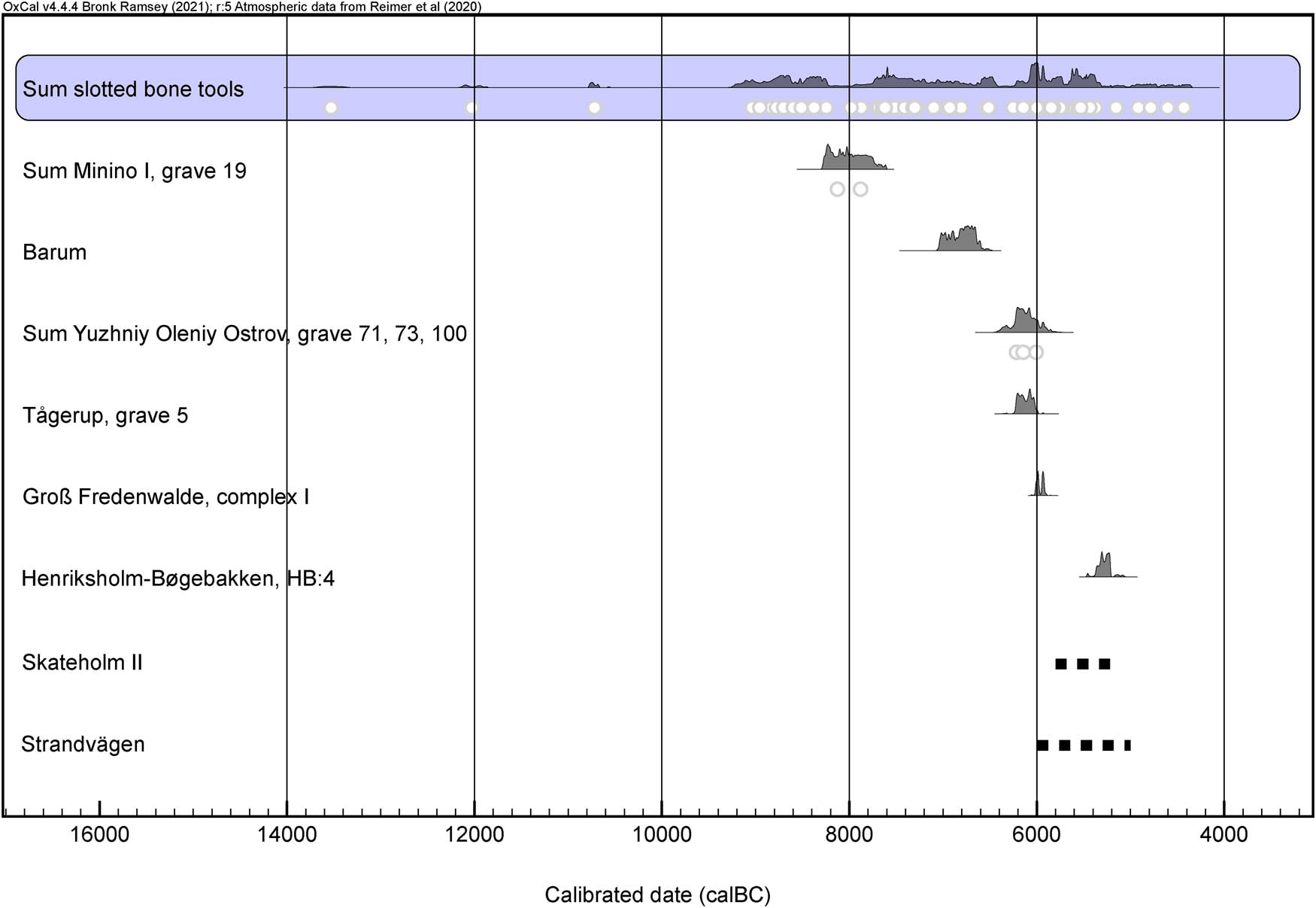
Radiocarbon data of slotted bone tools in Northern and Northeastern Europe and radiocarbon data from Mesolithic burials with slotted bone tools interpreted as grave goods. Minino I: terrestrial data (fauna); Yuzhniy Oleniy Ostrov: modelled data; Groß Fredenwalde: terrestrial data (tooth pendant). Graves with slotted bone tools without radiocarbon data: Strandvägen burial 03 and Skateholm II grave IV (estimated use of cemetery: dotted line) (data after Gummesson & Molin, 2016; Larsson, 2016; Manninen et al., 2021; Schulting et al., 2022).
This is also underlined by the flint artefacts from the site. They consist mostly of blades, some of them of extraordinary size. It is very likely that the raw material or the tools of the large specimens originate from areas with better raw material availability further north. Large blades were present in both burial phases at the site and were possibly a prestigious part of the grave goods. Very large blades are considered part of male equipment in the Mesolithic burial record of Northern Germany and Southern Scandinavia (cp. Kotula et al., 2022). The blades from the older phase cannot be reliably connected to a specific individual. They consist of a very long truncated blade (111 mm) as well as other blades (mean length 33 mm), which are above average size compared to northeastern German inland inventories of this Mesolithic phase (Kotula et al., 2022). The grave goods of the more recent burial include bone tools and a set of flint blades, suggesting that the individual was a (flint) craftsman. Two truncations from the same burial are of extraordinary size and indicate a northern origin (Figure 9). It has been suggested that flint artefact sizes in burials exceed the sizes of settlement material (Grünberg, 2000, p. 114) and the Groß Fredenwalde site can provide supporting evidence for this. The flint artefacts underline the northern connections of the site in both phases. The size and quality of flint artefacts is connected to good raw materials availability, and larger tools therefore prevail in Southern Scandinavia. Truncated blades are regularly present in the Northeastern German Mesolithic burial record, and a truncation was also uncovered at Berlin-Schmöckwitz (Gramsch, 2016). A large flint knife is also known from grave A162 at the Nivå 10 site, but large blades are especially present at the younger Scandinavian burial sites like Strøby Egede and Henriksholm-Bøgebakken in Denmark (Brinch Petersen, 1988; Grünberg, 2000). The character of the flint artefacts emphasizes the long-lasting northern connections of the Groß Fredenwalde people.
5 Conclusion
Groß Fredenwalde is the largest Mesolithic cemetery in North-central Europe and the earliest cemetery with primary inhumations in Germany. Its appearance coincides with an increase in inhumation cemetery sites in Northern and North-eastern Europe in the early Atlantic. In the earlier phase, the site is characterized by a high burial activity around c. 6300/6200–5800 cal BC. Radiocarbon dates from the site and some pathological markers on the human remains as well as a high proportion of children may hint at a connection of the earlier burial phase of Groß Fredenwalde with the sudden climatic downfall of the 8.2 ka event, but a possible connection needs to be investigated further. The prominent hill without settlement traces nearby was probably chosen as a specific location related to resources/territory and is comparable to some other cemeteries in the investigated period. Groß Fredenwalde is characterized by a high burial activity within a restricted time frame and a younger, less active phase of use, which also finds parallels at other sites in Northern Europe. In the investigated area, burial places regularly appear to be remembered and resumed. In the case of Groß Fredenwalde, a unique territorial situation with the local presence of early farmers may be connected to the resumption.
Especially the slotted bone dagger as well as the flint blades probably made of non-local raw material indicate strong and long-lasting northern connections. Groß Fredenwalde was part of a Northern European area where slotted technology was introduced from the east and subsequently became more widespread in the early Atlantic. The wheatsheaf-motif on the dagger generally links it to the Scandinavian Kongemose culture. Ochre and tooth pendants from the graves find parallels in Southern Scandinavia and Eastern Europe. The flint artefacts indicate more immediate northern connections to areas with good raw material availability, possibly Rügen island or even Southern Denmark. These northern connections are visible in both phases of the cemetery and display a network upheld independently through the hiatus of burial tradition.
-
Funding information: The interdisciplinary research project is financially supported by the Deutsche Forschungsgemeinschaft (PI 1120/3-1; SCHE 2082/1-1; TE 259/17-1).
-
Conflict of interest: The authors state no conflict of interest.
References
Amkreutz, L. (2022). A view from Doggerland – interpreting the Mesolithic-Neolithic transition in the wetlands of the Rhine-Meuse delta (5500–2500 cal BC). In F. Klimscha, M. Heumüller, D. C. M. Raemaekers, H. Peters, & T. Terberger (Eds.), Stone age borderland experience: Neolithic and late Mesolithic parallel societies in the North European plain (Materialhefte zur Ur- und Frühgeschichte Niedersachsens, 60, pp. 311–326). Rahden/Westf.: Verlag Marie Leidorf.Suche in Google Scholar
Arwidsson, G. (1949). Stenåldersfynden från Kams i Lummelunda. Gotländskt Arkiv. Meddelanden från Föreningen Gotlands Fornvänner, XX–XXI, 147–169.Suche in Google Scholar
Brinch Petersen, E. (1988). Ein mesolithisches Grab mit acht Personen von Strøby Egede, Seeland. Archaologisches Korrespondenzblatt, 18, 121–125.Suche in Google Scholar
Brinch Petersen, E. (2015). Diversity of Mesolithic Vedbæk (Acta Archaeologica 86/1 = Acta Archaeologica Supplementa 16). Oxford: Wiley.10.1111/j.1600-0390.2015.12013.xSuche in Google Scholar
Brinch Petersen, E. (2016). Afterlife in the Danish Mesolithic – the creation, use and discarding of “Loose Human Bones.” In J. Grünberg, B. Gramsch, L. Larsson, J. Orschiedt, & H. Meller (Eds.), Mesolithic burials – Rites, symbols and social organisation of early postglacial communities (Tagungen des Landesmuseums für Vorgeschichte Halle, 13, pp. 47–62). Halle: Landesamt für Denkmalpflege und Archäologie Sachsen-Anhalt – Landesmuseum für Vorgeschichte.Suche in Google Scholar
Bugajska, K. (2020). Cremation burials of Stone age hunter-gatherers on the European plain. Światowit, LIX, 15–45.10.31338/0082-044X.swiatowit.59.4Suche in Google Scholar
Bugajska, K., & Gumiński, W. (2016). How many steps to heaven? Loose human bones and secondary burials at Dudka and Szczepanki, the Stone age foragers’ sites in Masuria, NE-Poland. In J. Grünberg, B. Gramsch, L. Larsson, J. Orschiedt, & H. Meller (Eds.), Mesolithic burials – Rites, symbols and social organisation of early postglacial communities (Tagungen des Landesmuseums für Vorgeschichte Halle, 13, pp. 511–544). Halle: Landesamt für Denkmalpflege und Archäologie Sachsen-Anhalt – Landesmuseum für Vorgeschichte.Suche in Google Scholar
Butrimas, A. (2016). Biržulis lake islands Donkalnis and Spiginas Mesolithic cemeteries (West Lithuania). In J. Grünberg, B. Gramsch, L. Larsson, J. Orschiedt, & H. Meller (Eds.), Mesolithic burials – Rites, symbols and social organisation of early postglacial communities (Tagungen des Landesmuseums für Vorgeschichte Halle, 13, pp. 193–217). Halle: Landesamt für Denkmalpflege und Archäologie Sachsen-Anhalt – Landesmuseum für Vorgeschichte.Suche in Google Scholar
Clare, L., Rohling, E. J., Weninger, B., Hilpert, J. (2008). Warfare in Late Neolithic\Early Chalcolithic Pisidia, Southwestern Turkey. Climate induced social unrest in the late 7th Millennium cal BC. Documenta Praehistorica, XXXV, 65–92.10.4312/dp.35.6Suche in Google Scholar
Clark, G. A., & Neeley, M. (1987). Social differentiation in European Mesolithic burial data. In P. Rowley-Conwy, M. Zvelebil, & H. P. Blankholm (Eds.), Mesolithic northwest Europe: Recent trends (pp. 121–127). Sheffield: Department of Archaeology and Prehistory, University of Sheffield.Suche in Google Scholar
Conneller, C. (2013). Power and society. Mesolithic Europe. In L. Nilsson Stutz & S. Tarlow (Eds.), The Oxford handbook of the archaeology of death and burial (pp. 347–358). Oxford: Oxford University Press.Suche in Google Scholar
Gehlen, B., & Schön, W. (2005). Klima und Kulturwandel: Mögliche Folgen des “6200-Events” in Europa. Climate and cultural change – possible consequences of the “6200 Event” in Europe. In D. Gronenborn (Ed.), Klimaveränderungen und Kulturwandel in neolithischen Gesellschaften Mitteleuropas, 6700 – 2200 cal BC. 6700 – 2200 cal BC (RGZM Tagungen 1, pp. 53–72). Mainz: Schnell & Steiner.Suche in Google Scholar
Geisler, H., & Wetzel, G. (1999). Mittelsteinzeitliche und mittelalterliche Bestattungen vom “Rollmannsberg” bei Criewen, Lkr. Uckermark. In E. Cziesla, T. Kersting, & S. Pratsch (Eds.), Den Bogen spannen. Festschrift für B. Gramsch zum 65. Geburstag (Beiträge zur Ur- und Frühgeschichte Mitteleuropas, 20, pp. 259–280). Weissbach: Beier&Beran.Suche in Google Scholar
Gibaja, J. F., Subirà, M. E., Terradas, X., Santos, F. J., Agulló, L., Gómez-Martínez, I., … Fernández-López de Pablo, J. (2015). The emergence of Mesolithic cemeteries in SW Europe: Insights from the El Collado (Oliva, Valencia, Spain) radiocarbon record. PLoS One, 10(1), e0115505. doi: 10.1371/journal.pone.0115505.Suche in Google Scholar
Gramsch, B. (2016). The Mesolithic burials of north-eastern Germany: Synopsis and new aspects. In J. Grünberg, B. Gramsch, L. Larsson, J. Orschiedt, & H. Meller (Eds.), Mesolithic burials – Rites, symbols and social organisation of early postglacial communities (Tagungen des Landesmuseums für Vorgeschichte Halle, 13, pp. 385–400). Halle: Landesamt für Denkmalpflege und Archäologie Sachsen-Anhalt – Landesmuseum für Vorgeschichte.Suche in Google Scholar
Gramsch, B., & Schoknecht, U. (2003). Groß Fredenwalde, Lkr. Uckermark – eine mittelsteinzeitliche Mehrfachbestattung in Norddeutschland. Veröffentlichen zur Brandenburgischen Landesarchäologie, 34, 9–38.Suche in Google Scholar
Grote, K., & Terberger, T. (2011). Die prähistorischen Kinderbestattungen vom Abri Bettenroder Berg IX im Reinhäuser Wald bei Göttingen. Archäologisches Korrespondenzblatt, 41, 189–195.Suche in Google Scholar
Grünberg, J. M. (2000). Mesolithische Bestattungen in Europa. Ein Beitrag zur vergleichenden Gräberkunde (Internationale Archaologie 40). Rahden/Westf: Leidorf Verlag.Suche in Google Scholar
Grünberg, J. M. (2013a). Rot in paläolithischen und mesolithischen Bestattungen. In H. Meller, C. H. Wunderlich, & F. Knoll (Eds.), Rot – Die Archäologie bekennt Farbe. 5. Mitteldeutscher Archäologentag vom 04. bis 06. Oktober 2012 in Halle (Saale) (Tagungen des Landesmuseums für Vorgeschichte Halle, 10, pp. 121–134). Halle: Landesamt für Denkmalpflege und Archäologie Sachsen-Anhalt – Landesmuseum für Vorgeschichte.Suche in Google Scholar
Grünberg, J. M. (2013b). Animals in Mesolithic burials in Europe. Anthropozoologica, 48, 231–253.10.5252/az2013n2a3Suche in Google Scholar
Grünberg, J. M. (2016). The Mesolithic burials of the Middle Elbe-Saale region. In J. Grünberg, B. Gramsch, L. Larsson, J. Orschiedt, & H. Meller (Eds.), Mesolithic burials – Rites, symbols and social organisation of early postglacial communities (Tagungen des Landesmuseums für Vorgeschichte Halle, 13, pp. 257–290). Halle: Landesamt für Denkmalpflege und Archäologie Sachsen-Anhalt – Landesmuseum für Vorgeschichte.Suche in Google Scholar
Gumiński, W., & Bugajska, K. (2016). Exception as a rule. Unusual Mesolithic cemetery and other graves at Dudka and Szczepanki, Masuria, NE-Poland. In J. Grünberg, B. Gramsch, L. Larsson, J. Orschiedt, & H. Meller (Eds.), Mesolithic burials – Rites, symbols and social organisation of early postglacial communities (Tagungen des Landesmuseums für Vorgeschichte Halle, 13, pp. 465–510). Halle: Landesamt für Denkmalpflege und Archäologie Sachsen-Anhalt – Landesmuseum für Vorgeschichte.Suche in Google Scholar
Gummesson, S. & Molin, F. (2016). The Mesolithic cemetery at Strandvägen, Motala, in eastern central Sweden. In J. Grünberg, B. Gramsch, L. Larsson, J. Orschiedt, & H. Meller (Eds.), Mesolithic burials – Rites, symbols and social organisation of early postglacial communities (Tagungen des Landesmuseums für Vorgeschichte Halle, 13, pp. 145–159). Halle: Landesamt für Denkmalpflege und Archäologie Sachsen-Anhalt – Landesmuseum für Vorgeschichte.Suche in Google Scholar
Gurina, N. N. (1956). Oleneostrovskij Mogil’nik (Materialy i issledovanija po archeologii SSSR 47). Moscow–Leningrad: Moskva Izdat. Akad. Nauk SSSR (in Russian).Suche in Google Scholar
Hartz, S., Jöns, H., Lübke, H., Schmölcke, U., von Carnap-Bornheim, C., Heinrich, D., … Wolters, S. (2014). Prehistoric Settlements in the southwestern Baltic Sea area and development of the regional Stone Age economy. Bericht der Römisch-Germanischen Kommission, 92(2011), 77–210.Suche in Google Scholar
Ismail-Weber, M. (2017). …100 km from the next settlement… Mobility of linear pottery groups in Brandenburg, North-Eastern Germany. In S. Scharl & B. Gehlen (Eds.), Mobility in Prehistoric Sedentary Societies. Papers of the CRC 806 Workshop in Cologne 26–27 June 2015 (Kölner Studien zur prähistorischen Archäologie, 8, pp. 75–117). Köln: Marie Leidorf.Suche in Google Scholar
Jacobs, K. (1995). Returning to Oleni’ ostrov: Social, economic, and skeletal dimensions of a boreal forest Mesolithic cemetery. Journal of Anthropological Archaeology, 14, 359–403.10.1006/jaar.1995.1018Suche in Google Scholar
Jensen, O. L. (2016). Double burials and cremations from the late Mesolithic site of Nivå 10, Eastern Denmark. In J. Grünberg, B. Gramsch, L. Larsson, J. Orschiedt, & H. Meller (Eds.), Mesolithic burials – Rites, symbols and social organisation of early postglacial communities (Tagungen des Landesmuseums für Vorgeschichte Halle, 13, pp. 95–108). Halle: Landesamt für Denkmalpflege und Archäologie Sachsen-Anhalt – Landesmuseum für Vorgeschichte.Suche in Google Scholar
Jungklaus, B., Kotula, A., & Terberger, T. (2016). New investigations into the Mesolithic burial of Groß Fredenwalde, Brandenburg – first results. In J. Grünberg, B. Gramsch, L. Larsson, J. Orschiedt, & H. Meller (Eds.), Mesolithic burials – Rites, symbols and social organisation of early postglacial communities (Tagungen des Landesmuseums für Vorgeschichte Halle, 13, pp. 419–433). Halle: Landesamt für Denkmalpflege und Archäologie Sachsen-Anhalt – Landesmuseum für Vorgeschichte.Suche in Google Scholar
Karsten, P., & Knarrström, B. (2001). Tågerup specialstudier. Lund: Riksantikvarieämbetet.Suche in Google Scholar
Kotula, A., Jungklaus, B., Lüdemann, N., Piezonka, H., & Terberger, T. (2022). The unusual last journey of a flint knapper c. 7000 years ago – a late Mesolithic burial from Groß Fredenwalde (Brandenburg, NE-Germany). In M. Grygiel & P. Obst (Eds.), Walking among ancient Trees. Studies in honour of Ryszard Grygiel and Peter Bogucki on the 45th anniversary of their research collaboration (pp. 115–134). Łódź: Fundacja Badań Archeologicznych Imienia Profesora Konrada Jażdżewskiego.Suche in Google Scholar
Kotula, A., Piezonka, H., & Terberger, T. (2020). The Mesolithic cemetery of Groß Fredenwalde (NE Germany) and its cultural affiliations. Lietuvos Archeologija, 46, 65–84.10.33918/25386514-046002Suche in Google Scholar
Larsson, L. (2004). The Mesolithic period in Southern Scandinavia: With special reference to burials and cemeteries. In A. Saville (Ed.), Mesolithic Scotland and its neighbours. The Holocene prehistory of Scotland, its British and Irish context, and some Northern European perspectives (pp. 371–392). Edinburgh: Society of Antiquaries of Scotland.Suche in Google Scholar
Larsson, L. (2006). A tooth for a tooth. Tooth ornaments from the graves at the cemeteries of Zvejnieki. In L. Larsson & I. Zagorska (Eds.), Back to the Origin. New Research in the Mesolithic-Neolithic Zvejnieki Cemetery and Environment, Northern Latvia (Acta Archaeologica Lundensia, Series 8°, No 52, pp. 253–287). Stockholm: Almqvist & Wiksell International.Suche in Google Scholar
Larsson, L. (2016). Some aspects of mortuary practices at the late Mesolithic cemeteries at Skateholm, southernmost Sweden. In J. Grünberg, B. Gramsch, L. Larsson, J. Orschiedt, & H. Meller (Eds.), Mesolithic burials – Rites, symbols and social organisation of early postglacial communities (Tagungen des Landesmuseums für Vorgeschichte Halle, 13, pp. 175–184). Halle: Landesamt für Denkmalpflege und Archäologie Sachsen-Anhalt – Landesmuseum für Vorgeschichte.Suche in Google Scholar
Larsson, L., & Zagorska, I. (Eds.). (2006). Back to the origin. New research in the Mesolithic-Neolithic Zvejnieki cemetery and environment, Northern Latvia (Acta Archaeologica Lundensia, Series 8°, No 52). Stockholm: Almqvist & Wiksell International.Suche in Google Scholar
Manninen, M. A., Asheichyk, V., Jonuks, T., Kriiska, A., Osipowicz, G., Sorokin, A. N., … Persson, P. (2021). Using radiocarbon dates and tool design principles to assess the role of composite slotted bone tool technology at the intersection of adaptation and culture-history. Journal of Archaeological Method and Theory, 28, 845–870. doi: 10.1007/s10816-021-09517-7.Suche in Google Scholar
Marciniak, M. (2001). The burial ritual from the boreal period cemetery in Mszano, Brodnica district. Fontes Archeologici Posnaniensens, 39, 95–123.Suche in Google Scholar
Meadows, J., Robson, H. K., Groß, D., Heege, C., Lübke, H., Schmölcke, U., … Gramsch, B. (2018). How fishy was the inland Mesolithic? New data from Friesack, Brandenburg, Germany. Radiocarbon, 60, 1621–1636.10.1017/RDC.2018.69Suche in Google Scholar
Meiklejohn, C., & Babb, J. (2009). Issues in burial chronology in the Mesolithic of northwestern Europe. In P. Crombé, M. van Strydonck, J. Sergant, M. Boudin, & M. Bats (Eds.), Chronology and evolution within the Mesolithic of north-west Europe: Proceedings of an international meeting, Brussels, May 30th–June 1st 2007 (pp. 217–238). Newcastle upon Tyne: Cambridge Scholars.Suche in Google Scholar
Meiklejohn, C., Brinch Petersen, E., & Babb, J. (2009). From single graves to cemeteries: An initial look at chronology in Mesolithic burial practice. In S. McCartan, R. Schulting, G. Warren, & P. Woodman (Eds.), Mesolithic Horizons. Papers presented at the Seventh International Conference on the Mesolithic in Europe, Belfast (pp. 639–649). Oxford: Oxbow Books.Suche in Google Scholar
Newell, R., Constandse-Westermann, T., & Meiklejohn, C. (1979). The skeletal remains of Mesolithic man in Western Europe: An evaluative catalogue. Journal of Human Evolution, 8, 1–228.Suche in Google Scholar
Nielsson Stutz, L. (2003). Embodied rituals and ritualized bodies. Tracing ritual practices in late Mesolithic burials (Acta Archaeologica Lundensia Series in 8°, No 46). Lund: Almqvist & Wiksell International.Suche in Google Scholar
Olsen, J., Heinemeier, J., Lübke, H., Lüth, F., & Terberger, T. (2010). Dietary habits and freshwater reservoir effects in bones from a Neolithic NE German cemetery. Radiocarbon, 52, 635–644.10.1017/S0033822200045665Suche in Google Scholar
Oshibkina, S. V. (2008). Mesolithic burial grounds and burial complexes in the forest zone of eastern Europe. Anthropology & Archeology of Eurasia, 46, 46–70.10.2753/AAE1061-1959460403Suche in Google Scholar
Oshibkina, S. V. (2016). Funeral rituals of the population of the Eastern Lake Onega region (based on materials from Popovo and Peschanitsa cemeteries). In J. Grünberg, B. Gramsch, L. Larsson, J. Orschiedt, & H. Meller (Eds.), Mesolithic burials – Rites, symbols and social organisation of early postglacial communities (Tagungen des Landesmuseums für Vorgeschichte Halle, 13, pp. 793–808). Halle: Landesamt für Denkmalpflege und Archäologie Sachsen-Anhalt – Landesmuseum für Vorgeschichte.Suche in Google Scholar
Pettitt, P. (2011). The Palaeolithic origins of human burial. London: Routledge.10.4324/9780203813300Suche in Google Scholar
Piotrowska, N., Tomczyk, J., Pawełczyk, S., & Stanaczek, L. M. (2019). Radiocarbon AMS dating of Mesolithic human remains from Poland. Radiocarbon, 61, 991–1007.10.1017/RDC.2018.66Suche in Google Scholar
Posth, C., Yu, H., Ghalichi, A., Rougier, H., Crevecoeur, I., Huang, Y., … Krause, J. (2023). Palaeogenomics of upper Palaeolithic to Neolithic European hunter-gatherers. Nature, 615, 117–126.10.1038/s41586-023-05726-0Suche in Google Scholar
Saxe, A. A. (1970). Social dimensions of mortuary practices. (PhD thesis). University of Michigan, Ann Arbour.Suche in Google Scholar
Schoknecht, U. (1963). Neolithische Flachgräber von Groß Fredenwalde, Kr. Templin. Ausgrabungen und Funde, 8, 173–178.Suche in Google Scholar
Schulting, R. (1996). Antlers, bone pins and flint blades: the Mesolithic cemeteries of Téviec and Hoëdic, Brittany. Antiquity, 70, 335–350.10.1017/S0003598X00083319Suche in Google Scholar
Schulting, R. J., Mannermaa, K., Tarasov, P. E., Higham, T., Ramsey, C. B., Khartanovich, V., … Weber, A. (2022). Radiocarbon dating from Yuzhniy Oleniy Ostrov cemetery reveals complex human responses to socio-ecological stress during the 8.2 ka cooling event. Nature Ecology & Evolution, 6, 155–162.10.1038/s41559-021-01628-4Suche in Google Scholar
Skar, B., Lidén, K., Eriksson, G., & Sellevold, B. (2016). A submerged Mesolithic grave site reveals remains of the first Norwegian seal hunters. In H. B. Bjerck, H. M. Breivik, S. E. Fretheim, E. L. Piana, B. Skar, A. M. Tivoli, & A. F. J. Zangrando (Eds.), Marine ventures - Archaeological perspectives on human-sea relations (pp. 225–239). Sheffield: Equinox.Suche in Google Scholar
Sørensen, S. A. (2016). Loose human bones from the Danish Mesolithic. In J. Grünberg, B. Gramsch, L. Larsson, J. Orschiedt, & H. Meller (Eds.), Mesolithic burials – Rites, symbols and social organisation of early postglacial communities (Tagungen des Landesmuseums für Vorgeschichte Halle, 13, pp. 63–72). Halle: Landesamt für Denkmalpflege und Archäologie Sachsen-Anhalt – Landesmuseum für Vorgeschichte.Suche in Google Scholar
Stattegger, K., & Leszczyńska, K. (2023). Rapid sea-level rise during the first phase of the Littorina transgression in the western Baltic Sea. Oceanologia, 65, 202–210.10.1016/j.oceano.2022.05.001Suche in Google Scholar
Terberger, T. (2006). Mesolithic group territories of the Northern Lowlands in discussion. In C.-J. Kind (Ed.), After the Ice Age. Settlements, subsistence and social development in the Mesolithic of Central Europe. Proceedings of the International Conference 9th to 12th of September 2003, Rotenburg/Neckar, Baden-Württemberg, Germany (pp. 221–235). Stuttgart: Theiss.Suche in Google Scholar
Terberger, T., Burger, J., Lüth, F., Müller, J., & Piezonka, H. (2018). Step by step – The Neolithisation of northern Central Europe in the light of stable isotope analyses. Journal of Archaeological Science, 99, 66–86.10.1016/j.jas.2018.08.004Suche in Google Scholar
Terberger, T., Kabaciński, J., & Kotula, A. (2021b). First meetings? The late Mesolithic and the Linear Pottery culture in northeast Germany. Materiały Zachodniopomorskie, XVII, 163–193.Suche in Google Scholar
Terberger, T., Kotula, A., Jungklaus, B., & Piezonka, H. (2021a). The Mesolithic “multiple burial” of Groß Fredenwalde revisited. In S. Gaudzinski-Windheuser & O. Jöris (Eds.), The Beef behind all possible Pasts. The Tandem-Festschrift in honour of Elaine Turner and Martin Street (Monographien des Römisch-Germanischen Zentralmuseums, 157, pp. 671–688). Mainz: Verlag des Römisch-Germanischen Zentralmuseums.Suche in Google Scholar
Terberger, T., Kotula, A., Lorenz, S., Schult, M., Burger, J., & Jungklaus, B. (2015). Standing upright to all eternity – The Mesolithic burial site at Groß Fredenwalde, Brandenburg (NE Germany). Quartär, 62, 133–153.Suche in Google Scholar
Tõrv, M. (2018). Persistent Practices. A multi-disciplinary study of hunter-gatherer mortuary remains from c. 6500–2600 cal. BC, Estonia (Untersuchungen und Materialien zur Steinzeit in Schleswig-Holstein und im Ostseeraum 9). Kiel, Hamburg: Wachholtz Verlag.Suche in Google Scholar
Trotter, M., & Gleser, G. C. (1952). Estimation of stature from long bones of American Whites and Negroes. American Journal of Physical Anthropology, 10, 463–514.10.1002/ajpa.1330100407Suche in Google Scholar
Volk, A. A., & Atkinson, J. A. (2013). Infant and child death in the human environment of evolutionary adaptation. Evolution and Human Behavior, 34, 182–192.10.1016/j.evolhumbehav.2012.11.007Suche in Google Scholar
Voss, A. (1960). Danske flintaegdolke. Aarbøger, 1960, 153–167.10.25291/VR/1960-VR-153Suche in Google Scholar
Wechler, K.-P. (1989). Steinzeitliche Rötelgräber von Schöpsdorf, Kr. Hoyerswerda. Veröffentlichungen des brandenburgischen Landesmuseums für Ur-. Und Frühgeschichte, 23, 41–54.Suche in Google Scholar
Wood, R. E., Higham, T. F. G., Buzilhova, A., Suvorov, A., Heinemeier, J., & Olsen, J. (2013). Freshwater radiocarbon reservoir effects at the burial ground of Minino, northwest Russia. Radiocarbon, 55, 163–177.10.2458/azu_js_rc.v55i1.16448Suche in Google Scholar
Zagorska, I. (2008). The use of ochre in Stone age burials of the east Baltic. In F. Fahlander & T. Oestigaard (Eds.), The materiality of death, bodies, burials, beliefs (BAR International Series, 1768, pp. 115–124). Oxford: Archaeopress.Suche in Google Scholar
Zagorska, I. (2016). Mesolithic burial traditions in Latvia. A case study from Zvejnieki burial ground. In J. Grünberg, B. Gramsch, L. Larsson, J. Orschiedt, & H. Meller (Eds.), Mesolithic burials – Rites, symbols and social organisation of early postglacial communities (Tagungen des Landesmuseums für Vorgeschichte Halle, 13, pp. 225–239). Halle: Landesamt für Denkmalpflege und Archäologie Sachsen-Anhalt – Landesmuseum für Vorgeschichte.Suche in Google Scholar
Zagorskis, F. (2004). Zvejnieki (Northern Latvia) Stone age cemetery (BAR International Series, 1292). Oxford: Archaeopress.10.30861/9781841716428Suche in Google Scholar
© 2023 the author(s), published by De Gruyter
This work is licensed under the Creative Commons Attribution 4.0 International License.
Artikel in diesem Heft
- Regular Articles
- A 2D Geometric Morphometric Assessment of Chrono-Cultural Trends in Osseous Barbed Points of the European Final Palaeolithic and Early Mesolithic
- Wealth Consumption, Sociopolitical Organization, and Change: A Perspective from Burial Analysis on the Middle Bronze Age in the Carpathian Basin
- Everything Has a Role to Play: Reconstruction of Vessel Function From Early Copper Age Graves in the Upper Tisza Region (Eastern Hungary)
- Urban Success and Urban Adaptation Over the Long Run
- Exploring Hypotheses on Early Holocene Caspian Seafaring Through Personal Ornaments: A Study of Changing Styles and Symbols in Western Central Asia
- Victims of Heritage Crimes: Aspects of Legal and Socio-Economic Justice
- On the (Non-)Scalability of Target Media for Evaluating the Performance of Ancient Projectile Weapons
- Small Houses of the Dead: A Model of Collective Funerary Activity in the Chalcolithic Tombs of Southwestern Iberia. La Orden-Seminario Site (Huelva, Spain)
- Bigger Fish to Fry: Evidence (or Lack of) for Fish Consumption in Ancient Syracuse (Sicily)
- Terminal Ballistics of Stone-Tipped Atlatl Darts and Arrows: Results From Exploratory Naturalistic Experiments
- First Archaeological Record of the Torture and Mutilation of Indigenous Mapuche During the “War of Arauco,” Sixteenth Century
- The Story of the Architectural Documentation of Hagia Sophia’s Hypogeum
- Iconographic Trends in Roman Imperial Coinage in the Context of Societal Changes in the Second and Third Centuries CE: A Small-Scale Test of the Affluence Hypothesis
- Circular Economy in the Roman Period and the Early Middle Ages – Methods of Analysis for a Future Agenda
- New Insights Into the Water Management System at Tetzcotzinco, Mexico
- How Linguistic Data Can Inform Archaeological Investigations: An Australian Pilot Study Around Combustion Features
- Leadership in the Emergent Baekje State: State Formation in Central-Western Korea (ca. 200–400 CE)
- Middle Bronze Age Settlement in Czeladź Wielka – The Next Step Toward Determining the Habitation Model, Chronology, and Pottery of the Silesian-Greater Poland Tumulus Culture
- On Class and Elitism in Archaeology
- Archaeology of the Late Local Landscapes of the Hualfín Valley (Catamarca, Argentina): A Political Perspective from Cerro Colorado of La Ciénaga de Abajo
- Review Article
- The State of the Debate: Nuragic Metal Trade in the Bronze Age and Early Iron Age
- A Review of Malta’s Pre-Temple Neolithic Pottery Wares
- Commentary Article
- Paradise Found or Common Sense Lost? Göbekli Tepe’s Last Decade as a Pre-Farming Cult Centre
- Special Issue Published in Cooperation with Meso’2020 – Tenth International Conference on the Mesolithic in Europe, edited by Thomas Perrin, Benjamin Marquebielle, Sylvie Philibert, and Nicolas Valdeyron - Part II
- The Time of the Last Hunters: Chronocultural Aspects of Early Holocene Societies in the Western Mediterranean
- Fishing Nets and String at the Final Mesolithic and Early Neolithic Site of Zamostje 2, Sergiev Posad (Russia)
- Investigating the Early-to-Late Mesolithic Transition in Northeastern Italy: A Multifaceted Regional Perspective
- Socioeconomic, Technological, and Cultural Adaptation of the Mesolithic Population in Central-Eastern Cantabria (Spain) in the Early and Middle Holocene
- From Coastal Sites to Elevated Hinterland Locations in the Mesolithic – Discussing Human–Woodland Interaction in the Oslo Fjord Region, Southeast Norway
- Exploitation of Osseous Materials During the Mesolithic in the Iron Gates
- Motorways of Prehistory? Boats, Rivers and Moving in Mesolithic Ireland
- Environment and Plant Use at La Tourasse (South-West France) at the Late Glacial–Holocene Transition
- Stylistic Study of the Late Mesolithic Industries in Western France: Combined Principal Coordinate Analysis and Use-Wear Analysis
- Mesolithic Occupations During the Boreal Climatic Fluctuations at La Baume de Monthiver (Var, France)
- Pressure Flakers of Late Neolithic Forest Hunter-Gatherer-Fishers of Eastern Europe and Their Remote Counterparts
- The Site Groß Fredenwalde, NE-Germany, and the Early Cemeteries of Northern Europe
- Special Issue on Archaeology of Migration: Moving Beyond Historical Paradigms, edited by Catharine Judson & Hagit Nol
- The Blurry Third Millennium. “Neolithisation” in a Norwegian Context
- Movement or Diaspora? Understanding a Multigenerational Puebloan and Ndee Community on the Central Great Plains
- Human Mobility and the Spread of Innovations – Case Studies from Neolithic Central and Southeast Europe
- The Thule Migration: A Culture in a Hurry?
- The Transformation of Domes in Medieval Chinese Mosques: From Immigrant Muslims to Local Followers
- Landscapes of Movement Along the (Pre)Historical Libyan Sea: Keys for a Socio-Ecological History
- Arab Migration During Early Islam: The Seventh to Eighth Century AD from an Archaeological Perspective
- Special Issue on Ancient Cultural Routes: Past Transportations Infrastructures as a Two-Way Interaction Between Society and Environment, edited by Francesca Fulminante, Francesca Mazzilli & Franziska Engelbogen
- The Impact of Transportation on Pottery Industries in Roman Britain
- The Role of the Road in Settling a Mountainous Region
- An Example of Geographic Network Analysis: The Case Study of the Fortore Valley (Molise and Apulia, Italy)
- Water, Communication, Sight, and the Location of Fortifications on the Strata Diocletiana (Syria) in Late Antiquity
- Transport, Interaction, and Connectivity
- Special Issue on Scales of Interaction in the Bronze and Iron Age Central Mediterranean, edited by Emily Holt & Davide Schirru
- Tracing Mobility Patterns of Buried Species of the Late Iron Age Funerary Staggered Turriform of Son Ferrer (Calvià, Spain)
- Approaching Interaction in Iron Age Sardinia: Multi-Scalar Survey Evidence from the Sinis Archaeological Project and the Progetto S’Urachi
- From the Atlantic to the Mediterranean and Back: Sardinia, Iberia, and the Transfer of Knowledge in Late Bronze Age Networks
- Special Issue on Bricks Under the Scope: Microscopic and Macroscopic Approaches to the Study of Earthen Architecture, edited by Marta Lorenzon, Moritz Kinzel, & Benjamín Cutillas-Victoria
- Earthen Architecture in Nordic Countries: Future Directions
- Earthen Architecture and Craft Practices of Early Iron Age Ramparts: Geoarchaeological Analysis of Villares de la Encarnación, South-Eastern Iberia
- Earthen Architecture in Southern Algeria: An Assessment of Social Values and the Impact of Industrial Building Practices
- Studying the Use of Earth in Early Architecture of Southwest and Central Asia
- Roof Tiles and Bricks of the Etruscan Domus dei Dolia (Vetulonia, Italy): An Archaeological and Archaeometric Study of Construction Materials
- The Building Blocks of Circular Economies: Rethinking Prehistoric Turf Architecture Through Archaeological and Architectural Analysis
- Undecorated Roman-Period Roof Tiles – An Old Material Providing New Results
- Turf Building in Iceland – Past, Present, and Future
- Special Issue on Past Sounds: New Perspectives in the Field of Archaeoacoustics, edited by Margarita Díaz-Andreu & Neemias Santos da Rosa
- Employing Psychoacoustics in Sensory Archaeology: Developments at the Ancient Sanctuary of Zeus on Mount Lykaion
- One, Two, Three! Can Everybody Hear Me? Acoustics of Roman Contiones. Case Studies of the Capitoline Hill and the Temple of Bellona in Rome
- Ringing Tone and Drumming Sages in the Crevice Cave of Pirunkirkko, Koli, Finland
- Music and Storytelling at Rock Art Sites? The Archaeoacoustics of the Urkosh Area (Russian Altai)
- Listening in Sacred Spaces: The Sanctuary of Poseidonia and Selinunte’s Main Urban Sanctuary
- Presenting Archaeoacoustics Results Using Multimedia and VR Technologies
- Special Issue on Reconsidering the Chaîne Opératoire: Towards a Multifaceted Approach to the Archaeology of Techniques, edited by Marie-Elise Porqueddu, Claudia Sciuto & Anaïs Lamesa
- Reconsidering the Chaîne Opératoire: At the Crossroad Between People and Materials
- Materiality of Plaster Vessels: The Problem of Southwest Asian Neolithic White Ware
- The Chaîne Opératoire Approach for Interpreting Personal Ornament Production: Marble Beads in Copper Age Tuscany (Italy)
- Seriality and Individualization: Carving the Fluted Sarcophagi from Hierapolis of Phrygia
- Making Vessels for the Dead: Pottery-Making Practices, Chaîne Opératoire and the Use of Grog (Crushed Sherds) as a Technological and Cultural Choice during Late and Inca Periods in the Northwestern Argentine Region (Southern Andes)
- An Invention Shading Light to the Socio-History of Bonneuil Quarry Basin: The Roadheaders with Rotating Drill Bits
- The Ugly Duckling: Understanding the Making of an Early Copper Age Atypical Ceramic Vessel from the Great Hungarian Plain
- Synopsis of a Treasure. A Transdisciplinary Study of Medieval Gold Workings Biographies
- Identification of Ceramic Traditions on the Prehistoric Mines of Gavà (Barcelona, Spain)
Artikel in diesem Heft
- Regular Articles
- A 2D Geometric Morphometric Assessment of Chrono-Cultural Trends in Osseous Barbed Points of the European Final Palaeolithic and Early Mesolithic
- Wealth Consumption, Sociopolitical Organization, and Change: A Perspective from Burial Analysis on the Middle Bronze Age in the Carpathian Basin
- Everything Has a Role to Play: Reconstruction of Vessel Function From Early Copper Age Graves in the Upper Tisza Region (Eastern Hungary)
- Urban Success and Urban Adaptation Over the Long Run
- Exploring Hypotheses on Early Holocene Caspian Seafaring Through Personal Ornaments: A Study of Changing Styles and Symbols in Western Central Asia
- Victims of Heritage Crimes: Aspects of Legal and Socio-Economic Justice
- On the (Non-)Scalability of Target Media for Evaluating the Performance of Ancient Projectile Weapons
- Small Houses of the Dead: A Model of Collective Funerary Activity in the Chalcolithic Tombs of Southwestern Iberia. La Orden-Seminario Site (Huelva, Spain)
- Bigger Fish to Fry: Evidence (or Lack of) for Fish Consumption in Ancient Syracuse (Sicily)
- Terminal Ballistics of Stone-Tipped Atlatl Darts and Arrows: Results From Exploratory Naturalistic Experiments
- First Archaeological Record of the Torture and Mutilation of Indigenous Mapuche During the “War of Arauco,” Sixteenth Century
- The Story of the Architectural Documentation of Hagia Sophia’s Hypogeum
- Iconographic Trends in Roman Imperial Coinage in the Context of Societal Changes in the Second and Third Centuries CE: A Small-Scale Test of the Affluence Hypothesis
- Circular Economy in the Roman Period and the Early Middle Ages – Methods of Analysis for a Future Agenda
- New Insights Into the Water Management System at Tetzcotzinco, Mexico
- How Linguistic Data Can Inform Archaeological Investigations: An Australian Pilot Study Around Combustion Features
- Leadership in the Emergent Baekje State: State Formation in Central-Western Korea (ca. 200–400 CE)
- Middle Bronze Age Settlement in Czeladź Wielka – The Next Step Toward Determining the Habitation Model, Chronology, and Pottery of the Silesian-Greater Poland Tumulus Culture
- On Class and Elitism in Archaeology
- Archaeology of the Late Local Landscapes of the Hualfín Valley (Catamarca, Argentina): A Political Perspective from Cerro Colorado of La Ciénaga de Abajo
- Review Article
- The State of the Debate: Nuragic Metal Trade in the Bronze Age and Early Iron Age
- A Review of Malta’s Pre-Temple Neolithic Pottery Wares
- Commentary Article
- Paradise Found or Common Sense Lost? Göbekli Tepe’s Last Decade as a Pre-Farming Cult Centre
- Special Issue Published in Cooperation with Meso’2020 – Tenth International Conference on the Mesolithic in Europe, edited by Thomas Perrin, Benjamin Marquebielle, Sylvie Philibert, and Nicolas Valdeyron - Part II
- The Time of the Last Hunters: Chronocultural Aspects of Early Holocene Societies in the Western Mediterranean
- Fishing Nets and String at the Final Mesolithic and Early Neolithic Site of Zamostje 2, Sergiev Posad (Russia)
- Investigating the Early-to-Late Mesolithic Transition in Northeastern Italy: A Multifaceted Regional Perspective
- Socioeconomic, Technological, and Cultural Adaptation of the Mesolithic Population in Central-Eastern Cantabria (Spain) in the Early and Middle Holocene
- From Coastal Sites to Elevated Hinterland Locations in the Mesolithic – Discussing Human–Woodland Interaction in the Oslo Fjord Region, Southeast Norway
- Exploitation of Osseous Materials During the Mesolithic in the Iron Gates
- Motorways of Prehistory? Boats, Rivers and Moving in Mesolithic Ireland
- Environment and Plant Use at La Tourasse (South-West France) at the Late Glacial–Holocene Transition
- Stylistic Study of the Late Mesolithic Industries in Western France: Combined Principal Coordinate Analysis and Use-Wear Analysis
- Mesolithic Occupations During the Boreal Climatic Fluctuations at La Baume de Monthiver (Var, France)
- Pressure Flakers of Late Neolithic Forest Hunter-Gatherer-Fishers of Eastern Europe and Their Remote Counterparts
- The Site Groß Fredenwalde, NE-Germany, and the Early Cemeteries of Northern Europe
- Special Issue on Archaeology of Migration: Moving Beyond Historical Paradigms, edited by Catharine Judson & Hagit Nol
- The Blurry Third Millennium. “Neolithisation” in a Norwegian Context
- Movement or Diaspora? Understanding a Multigenerational Puebloan and Ndee Community on the Central Great Plains
- Human Mobility and the Spread of Innovations – Case Studies from Neolithic Central and Southeast Europe
- The Thule Migration: A Culture in a Hurry?
- The Transformation of Domes in Medieval Chinese Mosques: From Immigrant Muslims to Local Followers
- Landscapes of Movement Along the (Pre)Historical Libyan Sea: Keys for a Socio-Ecological History
- Arab Migration During Early Islam: The Seventh to Eighth Century AD from an Archaeological Perspective
- Special Issue on Ancient Cultural Routes: Past Transportations Infrastructures as a Two-Way Interaction Between Society and Environment, edited by Francesca Fulminante, Francesca Mazzilli & Franziska Engelbogen
- The Impact of Transportation on Pottery Industries in Roman Britain
- The Role of the Road in Settling a Mountainous Region
- An Example of Geographic Network Analysis: The Case Study of the Fortore Valley (Molise and Apulia, Italy)
- Water, Communication, Sight, and the Location of Fortifications on the Strata Diocletiana (Syria) in Late Antiquity
- Transport, Interaction, and Connectivity
- Special Issue on Scales of Interaction in the Bronze and Iron Age Central Mediterranean, edited by Emily Holt & Davide Schirru
- Tracing Mobility Patterns of Buried Species of the Late Iron Age Funerary Staggered Turriform of Son Ferrer (Calvià, Spain)
- Approaching Interaction in Iron Age Sardinia: Multi-Scalar Survey Evidence from the Sinis Archaeological Project and the Progetto S’Urachi
- From the Atlantic to the Mediterranean and Back: Sardinia, Iberia, and the Transfer of Knowledge in Late Bronze Age Networks
- Special Issue on Bricks Under the Scope: Microscopic and Macroscopic Approaches to the Study of Earthen Architecture, edited by Marta Lorenzon, Moritz Kinzel, & Benjamín Cutillas-Victoria
- Earthen Architecture in Nordic Countries: Future Directions
- Earthen Architecture and Craft Practices of Early Iron Age Ramparts: Geoarchaeological Analysis of Villares de la Encarnación, South-Eastern Iberia
- Earthen Architecture in Southern Algeria: An Assessment of Social Values and the Impact of Industrial Building Practices
- Studying the Use of Earth in Early Architecture of Southwest and Central Asia
- Roof Tiles and Bricks of the Etruscan Domus dei Dolia (Vetulonia, Italy): An Archaeological and Archaeometric Study of Construction Materials
- The Building Blocks of Circular Economies: Rethinking Prehistoric Turf Architecture Through Archaeological and Architectural Analysis
- Undecorated Roman-Period Roof Tiles – An Old Material Providing New Results
- Turf Building in Iceland – Past, Present, and Future
- Special Issue on Past Sounds: New Perspectives in the Field of Archaeoacoustics, edited by Margarita Díaz-Andreu & Neemias Santos da Rosa
- Employing Psychoacoustics in Sensory Archaeology: Developments at the Ancient Sanctuary of Zeus on Mount Lykaion
- One, Two, Three! Can Everybody Hear Me? Acoustics of Roman Contiones. Case Studies of the Capitoline Hill and the Temple of Bellona in Rome
- Ringing Tone and Drumming Sages in the Crevice Cave of Pirunkirkko, Koli, Finland
- Music and Storytelling at Rock Art Sites? The Archaeoacoustics of the Urkosh Area (Russian Altai)
- Listening in Sacred Spaces: The Sanctuary of Poseidonia and Selinunte’s Main Urban Sanctuary
- Presenting Archaeoacoustics Results Using Multimedia and VR Technologies
- Special Issue on Reconsidering the Chaîne Opératoire: Towards a Multifaceted Approach to the Archaeology of Techniques, edited by Marie-Elise Porqueddu, Claudia Sciuto & Anaïs Lamesa
- Reconsidering the Chaîne Opératoire: At the Crossroad Between People and Materials
- Materiality of Plaster Vessels: The Problem of Southwest Asian Neolithic White Ware
- The Chaîne Opératoire Approach for Interpreting Personal Ornament Production: Marble Beads in Copper Age Tuscany (Italy)
- Seriality and Individualization: Carving the Fluted Sarcophagi from Hierapolis of Phrygia
- Making Vessels for the Dead: Pottery-Making Practices, Chaîne Opératoire and the Use of Grog (Crushed Sherds) as a Technological and Cultural Choice during Late and Inca Periods in the Northwestern Argentine Region (Southern Andes)
- An Invention Shading Light to the Socio-History of Bonneuil Quarry Basin: The Roadheaders with Rotating Drill Bits
- The Ugly Duckling: Understanding the Making of an Early Copper Age Atypical Ceramic Vessel from the Great Hungarian Plain
- Synopsis of a Treasure. A Transdisciplinary Study of Medieval Gold Workings Biographies
- Identification of Ceramic Traditions on the Prehistoric Mines of Gavà (Barcelona, Spain)

